#some artists have very good sense of composition and flow
Text
“Argument - “Artists will just need to focus on telling stories through video games, animations, and comics.”
I have already mentioned the biggest problem with this argument–the AIs will be very capable of running on autopilot, and they will get just as good at telling stories as they are at making images and videos. They will produce novels, essays, and scripts in amounts that can fill the library-of-babel, each piece a composite of half quotations and unattributed swipings. All this auto-generated text can be processed by the image and video AIs to generate long-format media, and the cycle will be complete, self-contained, and human-free.
[...]
This will completely flood the realm of story and the future will find itself overwhelmingly ghost-written. The “anime” that you’ve been dreaming of making since you were 8, which you are willing to forsake all of art to produce, will get the attention it deserves in this environment–none. And when your dream project, regurgitated in moments by an AI, receives no attention, no clout, and no money, you will rest well knowing you earned it. Not even your mother will be able to find it in the unending surge of the Mega Feed. This wouldn’t be a problem on its own- you were otherwise never going to make the thing anyway- except that you will be ruining the market for everyone who is positioned to pull something off by their own efforts. You will gain nothing and hurt your friends and peers.
The idea that everyone will be empowered to tell their story is one of the few arguments for AI art that compels me, there’s a nuanced discussion to be had here, but I believe it is ultimately bankrupt. It is a nice sentiment, and I can empathize with the frustrations of being an artist who feels their skills do not measure up to the scope of their vision– but we’re overlooking something very important here. You don’t just want to tell your story, and you don’t just want to tell it well–you want it to matter that you told your story. The AIs will rob you, and everyone else, of this.
The execution of your petulant “vision” by the AIs will ensure that no one cares about your story, and that it is washed away in the heaving sea of AI dross. Your art already doesn’t get attention. It’s not going to get any more attention when it’s competing with the unending stream of self-generated and highly targeted comics, novels, images, films, games, and songs. As I’ve said, these AIs will not need to be prompted by humans for very long and will instead auto-respond to the ebb and flow of the internet, current news, real time sales, and even private conversations. After all, we have already readied these inputs for them. We all feel a little uncomfortable when our phone shows us an ad for something we mentioned to our friend over dinner, but what happens when it shows you a movie it made just for you about your break up? A song about that careless word from your mother? A finished version of that comic idea you started researching? You’ll start getting notifications saying- “Hey! Check out one thousand finished versions of your dream!” Our ambient digital systems already have intimate access to so many of the inputs that define our taste- in some sense we sold our souls long ago.
So, you may be able to tell your story, but at the cost of its complete irrelevancy, which will likely have the effect of making you resent that you ever had the idea in the first place. Stories don’t achieve their incredible effect simply by existing. They live and die on human connection and intellect. AI will not “democratize art”--that’s just one of the copy-pasted platitudes of those vapid marketing execs spoon-feeding you your own doom. In a democracy, your voice matters. In a world flooded by AI media, your voice has no chance of being heard.
I also want to point out here that the people making these things will depend on you thinking they hold the silver key to your artistic vision. They need you to feel worthless and like you missed your chance to tell your story. That you got too old, or don’t have the time or resources or ability or what-have-you; that way you will need their product. This way you will support them monetarily and, most importantly, you will help them change the laws and sway the culture to allow their rapacious strip mining of all creative labor. They will always be incentivized to make you feel lowly, dependent, incapable, and slave to their kaiju whims.
And when they’re done, they’ll pull the rug out from under you, of course. They have no actual reason to let you have this stuff for free- they don’t care about you. They can say they do but that means nothing. Once they’ve made it impossible for you to make a living as an artist, and you’ve helped them change the laws, and they’ve ostracized you from your peers by turning you against them, they’ll just take it away and sell it to Google and Facebook and YouTube and the rest- because they stand to make billions from them and nothing from you.”
— excerpt from “The End of Art: An Argument Against Image AIs”
#this is maybe the best argument for non-artists against ai art ive ever heard#like why else would people be so secretive about the prompts they feed ais#if they did not in the end aspire to create great works of art themselves?#the whole video is great but this is maybe the most compelling argument for folks who are not 'artists' in the traditional sense#moon's thoughts
6 notes
·
View notes
Text
Week 5 - Worksheet + Exhibition
Worksheet 1
Reading a photographic series:
First Impression - Visually, the photos make sense together as a series. Every photo is of people's clothes, focusing in on their torso region. The second thing I noticed was the colors. Each outfit is mostly dominated by one color or by types of colors. As a series, the images are sequencing in a way that makes each image feel like it flows well one to the next.
Themes - This is a series rather than a collection of images because the images all work together to tell the message. The images visually are of the same thing. This series appears to be about the style choices one makes with their clothing and how we present a sense of self through our clothes and what we the viewer's interpret from one's clothing.
Title - Crossing the Line by Magali Nougarède
Sequencing - the author has chosen a thematic arrangement for the series. This influences the reading of the images because it causes me to try and understand them together as whole and how each photo engages with the others.
Last impressions - I now have a deeper understanding of these photos then I did before. They now make more sense as a whole than just with the visual component.
Dorothy Bohm’s London Street Markets
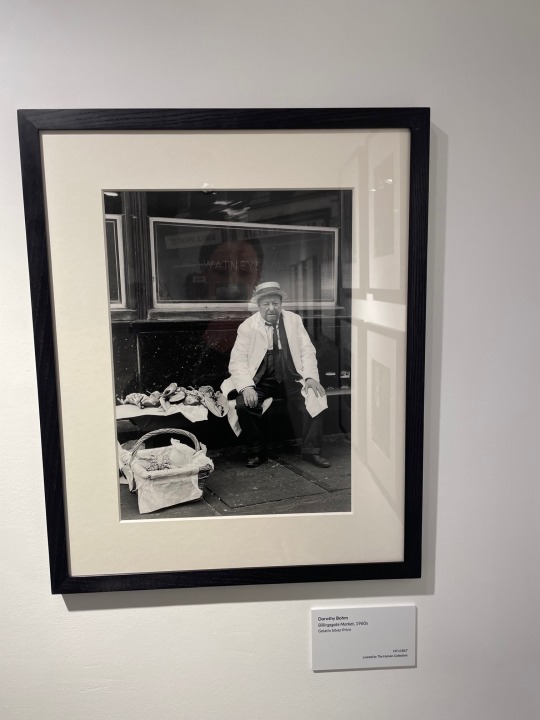
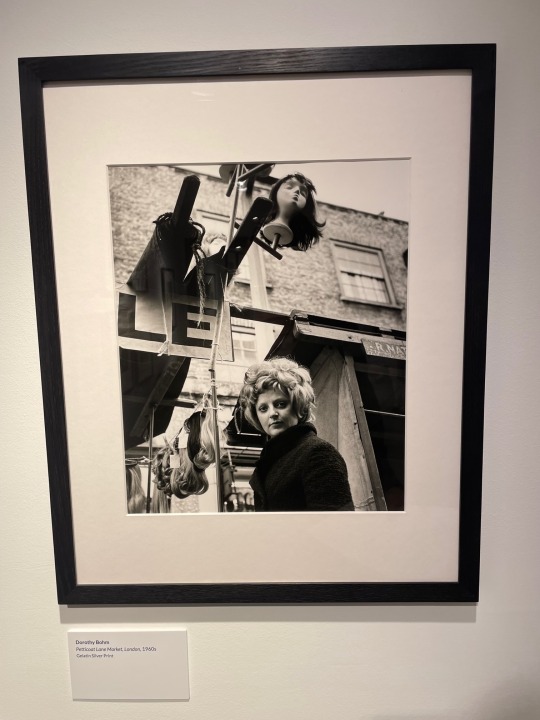

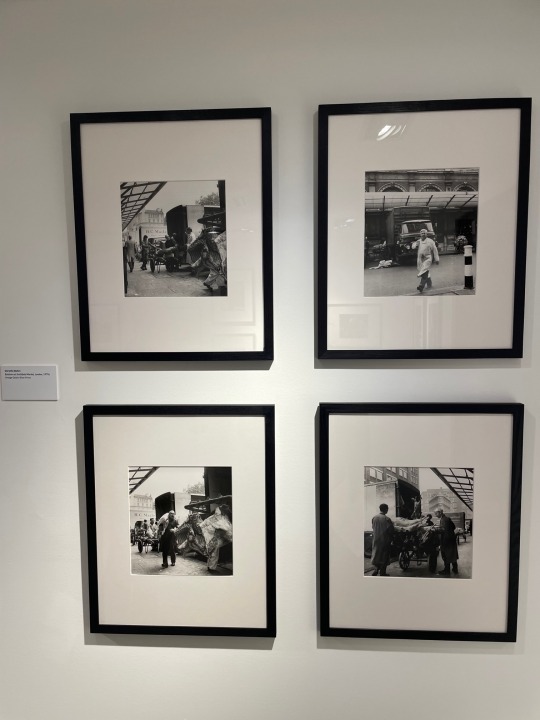
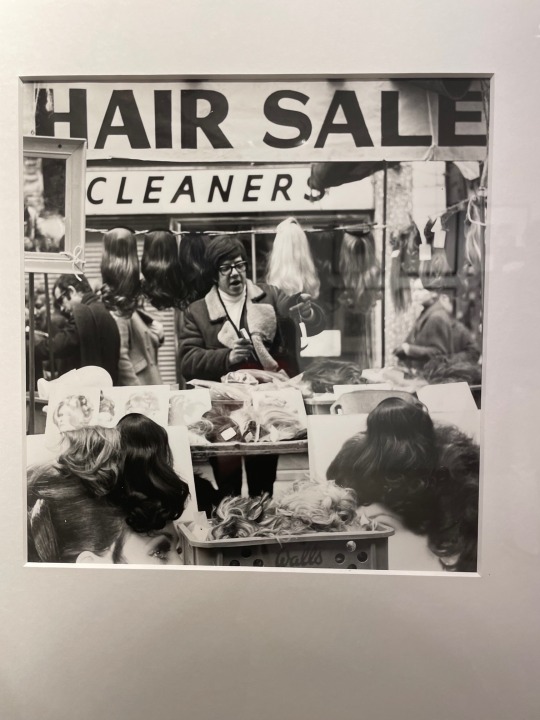
Upon viewing this series, it seems the artist is trying to showcase the people of the markets; the vendors who sell their goods and come week in and week out. The series consists of some portraits of the vendors and photographs of the market itself, focusing on the setting. In the portraits, the background of the stand and the goods the person is selling feels equally important as the person in the photograph.
The framing of the photographs puts an equal emphasis on the person and the background of their stand. In the photo of the woman holding the doll, the expression on the woman’s face, her eyes and hands, and the angle of her gaze feel sad and pensive. The photograph of the man selling lobsters conveys a similar feeling. Although Bohm is farther away from the subject, shooting from eye level evokes a stronger emotional response from the viewer. Bohm captured her subjects in moments that feel slightly vulnerable due to the postures of the subjects and the camera’s positioning.
I would consider these good photographers. When I saw them for the first time, I felt they were all pleasing to the eye and each photograph complimented the other photographs in the series. The composition and somewhat consistent point of view, the setting of the markets, and the framing brings the photographs together as a series. For me, a good photograph has to be visually pleasing to the eye in regards to its composition. When there is something in the composition that sparks my interest and takes my gaze to a particular spot and then around or across the photograph through the lines or patterns or various shapes. The people in these photographs are made up of very rounded shapes and their faces carry a lot of emotion. The faces and people are what first caught my eye, and then through the straight lines in the background, the gaze was taken to what was behind the people and the goods they were selling.
Yes, these images convey the artist’s message. Her image captures the welcoming nature of street markets but also the hard working and humane nature of those who sell goods there. Her ability to convey emotion through her perspective conveys the humanity of her subjects.
Seeing these photographs together as a series creates a sense of community and shared determination between the various subjects. Each photograph focuses on a different vendor and the goods they sell. As a series, it feels similar to when you are in the market yourself and are viewing all the different stands the market has to offer. It takes the viewer of this series on a journey meeting different people and takes you into that place and that moment.
The written information gives me an insight into Dorothy Bohm and her relationship to London. It states that London’s street markets were one of the main ways she engaged with the city and with her community. This reinforced my initial interpretation of her wanting to convey the humanity of the subjects. After reading the text, it seems to me that these photographs captured not just the emotion and personality of the subjects but her own interaction with them and her connection to her community.
0 notes
Text
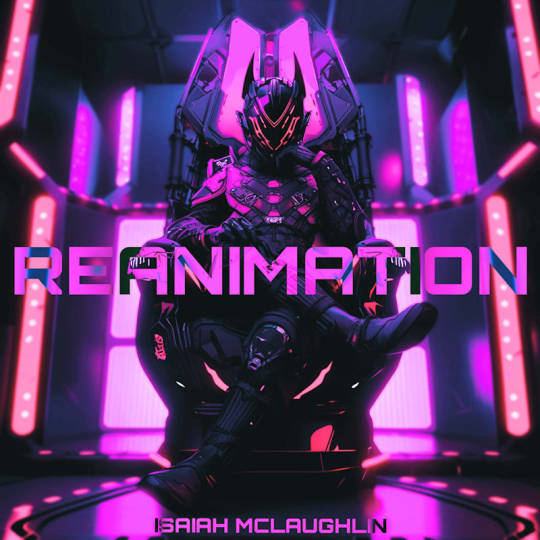
Isaiah McLaughlin has released a new album: Reanimation.
August 2023 - Isaiah McLaughlin has been quite busy creating amazing music. In fact, he has put out two albums, five EPs, and two singles available on all major music platforms. However, the artist has recently announced a brand new studio album titled Reanimation, which sets the bar even higher. This is a particularly special milestone for the artist, who actually considers this his best work to date. His assessment is quite spot-on, given not only the sheer variety of amazing sounds on tap but also the essence and passion that drive the artist's flow and compositions. To add to the excitement, it's amazing to think that Isaiah actually produced and wrote the songs all by himself!
The album features 14 tracks. The song "Stratosphere" offers some mesmerizing soundscapes, which perfectly match Isaiah's heartfelt lyrics and dream-like vocals. The following song, "Surrender to the Rhythm," stays true to its title with a fascinating backdrop of electronic grooves and distinctive sounds.
The track "Break the Chains" offers some ethereal and cinematic synthesizer sounds, lending a nocturnal, candle-lit vibe to the recording. This is one of the most interesting tunes on the record, and the arrangement is masterful. The song "Carnival" is just as colorful and imaginative as the title suggests, revealing the artist's broad creative range. The track "Jabba" is heavily focused on rhythm and melody, and the electronic sounds have a glitchy vibe that adds personality and character. The vocal samples are also fantastic, adding more tension and grandeur to the overall arrangement. The sixth track, "Crucify," is another fantastic piece of music that offers an insight into Isaiah's ability to create poetic, very personal, yet relatable lyrics. "Heavenly Droplets" is a bliss of otherworldly sounds, and it offers a very dynamic vibe that makes for an exciting addition to this album. The song "Crown" makes for yet another enticing and fascinating song on this release, and it paints a picture of sophistication and attention to detail.
"Heartbreaker" follows right after, and it stands out as one of the most emotional tunes on this entire record. In contrast, "Like a Bee" adds a more diverse approach, showcasing the insane range and versatility that makes Isaiah stand out. The following tune, "Fields of Gold," goes for a very ambitious and powerful yet intimate sound that captures the artist's ability to conjure up a wide range of feelings and emotions through music. "Sleep" is a very aural and beautifully hypnotic piece of music, highlighting the composition's ambiance. "The Park" is the next-to-last song on this release and a really good example of how Isaiah can write songs that feel quite personal but that people can instantly connect with. Last but not least, Reanimation is a perfect conclusion to this song, and it is a very powerful track that offers an outstanding and relatable flow until the end of the album.
Ultimately, this release shows that Isaiah has a deep love for music, and he is always eager to really connect with people through his songs. This album takes listeners on a captivating sonic voyage. From ethereal soundscapes to entrancing electronic rhythms, each composition showcases McLaughlin's exceptional creativity and emotional depth. Through masterful sound design, Isaiah managed to seamlessly construct a sonic realm that transcends mere music and traditional songwriting standards. The artist pioneered a very hard-to-define style, which almost feels like a sonic representation of an abstract space, loaded with thoughts and emotions in every note. Ethereal soundscapes, entrancing electronic rhythms, and evocative vocals collectively craft an alternate dimension, inviting listeners to lose themselves in its vivid tapestry and textural quality. rom soft, whispered moments that draw you into introspection to soaring intensities that electrify the senses, his vocal prowess becomes the vehicle for the album's emotional landscape.
Find out more about Isaiah McLaughlin, and do not miss out on Reanimation. Fans of artists as diverse as Michael Jackson, Prince, Active Child, and Son Lux should most definitely give this one a go! You can also find Isaiah on Instagram.
0 notes
Text
Song Analysis
Nat Moore
Composition - “Reroute Of The Wires”
Inspiration:
My main influences for this composition came from artists who show creativity and innovation through the use of common instruments and sounds. My composition does not contain 30 different tracks to produce and large ensemble. Instead, through the use of guitar, I used numerous effects and techniques to create interesting and compelling musical textures to achieve the criteria of this assignment. My main influences for this composition were:
Lorde, specifically her first album where she does not create powerful ensembles of sound but rather creates complexity through simplicity. Songs such as ‘Buzzcut Season’ and ‘Team’ were used extensively as influences for my song.
Radio Head’s ‘In Rainbows’ album also played a large role in the creation of my composition. This album mostly features a strong, dry, drum sound and a clean guitar sound which surprisingly keeps good character throughout the project. I wanted to emulate the guitar rhythms and characteristics (arpeggios, glides etc..) with my song.
I learnt numerous things during the recording and mixing process of my composition. Arguably the most prominent, is the relationship between electronic and acoustic instruments. The use of synths and guitar in my composition are weighed in a way that simultaneously compliments both parts as individuals and as an ensemble. In my previous experience, I would often separate the two.
How I constructed specific sounds:
The drums in the song are sampled from a Reddit user called ‘DCMoore322’ who records acoustic drum loops (royalty free). To the drums, I added light distortion and a chorus effect with a very low rate of effect but a high intensity. I did this to make sure the frequencies of the sample were a bit more spread out. To ensure this, I also used a stereo spread plugin to mesh out the frequencies to the left and right pans, similarly to a zipper on a jacket!
All the guitars on this track have a couple things in common: For one, I relentlessly used the artificial vibrato effect. I think that this effect holds a lot of melodic merit, especially when used on arpeggios because it allows the notes bend pitch constantly which emits more togetherness. All the guitar tracks also have some type of distortion/gain to add a bit more volume into the mix.
The synths, that come in during the “A’ section” of the song, were constructed using Logic pro’s stock ‘Retro Synth’ VST that lets you work with numerous effects and synth shapes. The two rhythmic synths use a saw shape oscillator with vibrato two create the wavering pulse in the middle ground. These two tracks are different through octaves and eq mixing. The last synth also uses a saw oscillator but this time with the envelope and LFO on max setting.
Creative Problems:
Some creative problems that I faced with this project were how I could smoothly transition between contrasting sections of the song. The main transition after the post-verse instrumental was attained by reversing the guitar track during the drum interval. This acted as a clue for change giving context to the transition. Without this reversed guitar, the transition would not make sense and it would sound unprepared and sloppy.
Another creative problem I faced was with the structure of the song. Following Cataplexy’s structure, I knew I had to clearly outline an intro/outro and contrasting sections. I’ve never had to have a structured route in which a project had to abide by so I did find it challenging to stick with it. What I discovered is that having a structure made it easier for the composition to flow as it created a floor for the composition to continue.
1 note
·
View note
Text
READINGS - Joan Mitchell: Drawing into Painting by Mark Lawrence Rosenthal.
Rosenthal, Mark Lawrence. Joan Mitchell: Drawing into Painting. Cheim & Read, 2016.

NOTES + QUOTES:
“As a teenager, Joan Mitchell was a competitive diver, tennis player, figure skater and horseback rider, activities that would endow her with a tough physical confidence that stood her in good stead as an artist. Even late in her life, athletic prowess provided a metaphor to characterize the full implications of her artistic practice, as when in 1986, she exclaimed, “Painting is a way of forgetting oneself…It’s like riding a bicycle with no hands. I call that state ‘no hands’... It’s a state of non self-consciousness…It is lovely.” With that sense of assuredness, Mitchell’s art is without personal anguish; instead it is brimming with self-possession - both in terms of her handling of paint and of her posture with regard to the art world” (Rosenthal).
“It is fascinating to contemplate the fact that another American abstract painting living in New York, Cy Twombly, also chose to depart for Europe. In his case the destination was Italy (he moved there in 1959) - a locus for his immersion in the art and literature of antiquity. The woman, Mitchell, and the gay man, Twombly, had both decided to abandon New York in order to embrace a culture they had long admired, even if those cultures represented faded glories. Too, their decision might well have reflected the degree to which they felt personally comfortable among the swashbuckler-crowd in New York. In effect, each chose to separate from that crucible of abstract painting in order to forge their new career phase within a different milieu” (Rosenthal).
“Very soon after Untitled of 1960, and throughout the mid-1960s, Mitchell introduced a new element into her pictorial vocabulary - a large, irregularly shaped, more-or-less black mass that dominates each composition. Versions of this shape and variations of the somber color appear repeatedly in these years, at times cloud-like, at other occasions heavy in pictorial weight. Mitchell’s dramatic and unidentifiable form added a degree of gravitas to what she exhibited in her 1960 Untitled. Compared to the all-over energy of that work, she imbued the subsequent paintings with a singular focus and concentration. It is not as if Mitchell’s characteristic vitality was absent; rather, its warriors strands were now restlessly bundled into one unknowable mass. Viewers of Mitchell’s earlier paintings found their eyes stilled and struck by a previously unseen type of mood. One might add to this discussion a point that Mitchell made, in 1986, that it is “without time…It never ends, it is the only thing that is both continuous and still. Then I can be very happy. It’s a still place. It’s like one word, one image.” With the black lumpy mass, she had effectively stilled the flow of time in her art, at least for the moment” (Rosenthal).
““My black paintings” is how Mitchell described this period in her work. Her characterization is particularly fascinating if one compares it to certain concurrent developments: starting in the late 1950s and continuing until the end of his life, Mark Rothko created his own series of dark, somber compositions; in 1959, Mitchell’s old friend Philip Guston began a major transition is his art that would evolve through the 1960s, whereby his palette changed from bright to largely black and gray, and his canvases became dominated by dark forms that would eventually become recognizable as heads; beginning in 1958, another acquaintance, Hans Hofmann added sizeable, albeit colorful, rectilinear blocks of color to his gestural style; finally, Tony Smith, a much-admired sculptor and friend of the New York School painters, made Die, a six-foot, cubic, black sculpture in 1962, in a darin premonition of all that would be soon called “Minimal Art.” Some new idea was certainly in the air on both sides of the Atlantic. In retrospect, one wonders whether this “trend,” if that is an accurate assessment, represented a newly imagined convergence between gestural painting and contemporaneous forms of planar abstraction, such as was practiced by Rothko, Ad Reinhardt and Barnett Newman, among others. In other words, an ambition became evident for a kind of rapprochement between the then dominant forms of abstraction” (Rosenthal).
“If the evolution of Mitchell’s art was from the appearance of rambunctious energy to a more concentrated, if no less emotional, vocabulary, the last phase of her career, from 1969 to her death in 1992, might be termed pictorially opulent. Now happily ensconced in Vétheuil, she embarked on a sustained period of extravagantly colored, large-scale paintings. Mitchell’s art overflowed with saturated blues, yellows, greens and oranges, and volatile and/or languorous brushstrokes, all packed densely together. Evocative of her surroundings, and recalling the styles of Monet, Paul Cézanne and Vincent van Gogh, the late works were imbued with her profound feelings about nature and its manifestations” (Rosenthal).
“Klaus Kertess memorably wrote than in Mitchell’s hands “‘Pastel’ is the chamber music of her greatness.” Another way to characterize her work in this medium is to call it a microcosm of her oeuvre. Not all artists who paint on a grand scale can translate their touch onto a sheet of paper, and in pastel no less, which is an exceedingly delicate medium. But here again, up close, one observes Mitchell’s consummate skills, for every stroke matters and is assured. She turned to pastel only at certain moments in her career, but more often late in her life. When she did, she created a body of highly refined works, with each a finished endeavor rather than a study or way station toward a larger painting. Taken together, the pastels exhibit a sensational variety of colors, moods and compositions” (Rosenthal).
“The earlier comparison between Mitchell nd Twombly was inspired by their nearly simultaneous turn from the New York art scene, a turned based on cultural predilection and, also, perhaps, triggered by matters concerning identity. They remained expatriates until the end of their lives, preferring the old world to the new. Not surprising given their European milieus, they exhibited a certain literary affinity in their art, with Mitchell comparing painting to poetry, and Twombly creating narratives based on literature from antiquity. Beyond lifestyle choices, one can point to a potential interplay between these two artists, too, as if each is occasionally learning from the other. Twombly tuned to Mitchell-like multi-panel works in the mid 1970s, making abstract narratives that swept across great expanses, as Mitchell had done starting in the mid-1960s. At about the same time in the 1970s, in other words, after Mitchell, Twombly made frequent use of great masses of dense color as a central formal protagonist of his artistic vocabulary” (Rosenthal).
“Indeed, with her work Mitchell induces the potential for a kind of revelation - about her exceedingly sentient character, her emotions before the grandeur of nature, and the sheer potential of color and paint to be transcendent. Mitchell’s art is an intense demonstration of what she feels to be alive in the world” (Rosenthal).

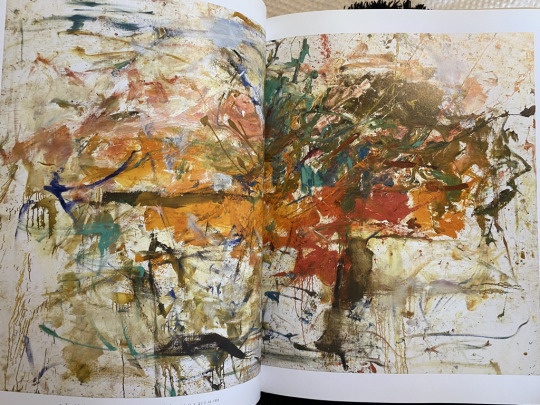
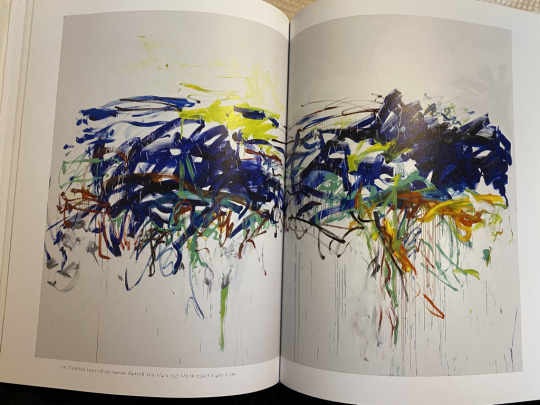
^ Images of Mitchell in her studio and of some of her works that are in the book.
I found this book really interesting and once again loved looking through all the images of Mitchell's works like I did when I did my earlier research post on her. She has really inspired me and even though at the moment our works don't physically look very similar, I think our intentions have overlapping interests.
1 note
·
View note
Note
To the owner of this blog can I just say- you’re legitimately one of my favorite artists like. Ever. I follow a lot of artists but your art style just vibes really hard and I don’t know why but it’s very very good and you are Improving Good and ah. Yes. The good shit. Like other then da vinky and shit you’re one of the best. Rant over aaa
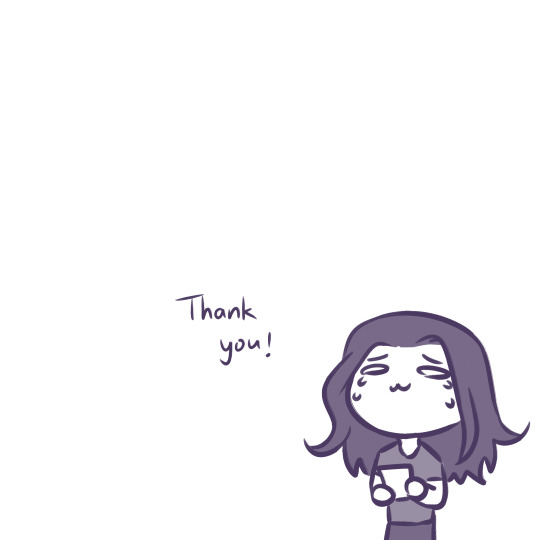
Sobs thank you so so much,,,,, I’ll seriously never get used to hearing that I’m someone’s favourite artist cos there’s so many others out there who have. better artist stats in my humble opinion ldahfljhdgjlasdhg
I’m really glad to hear that I’m improving!! I’m getting busier (and more tired aha) so I don’t exactly have a lot of energy to spare in terms of experimentations and studies, so I kinda thought that my style might stagnate which I know I will eventually hate. But I guess I’ve found ways to make small but significant adjustments to my style within my energy boundaries so that won’t be a problem in the near future XD
Thank you once again, I’m truly very grateful for this message and your support!!! I hope you guys can continue enjoying the blog as much as I do!! <3
#its me the mun#mun rambles#i seriously. will never get used to that lahflhdsflkjashgk#there are some times when i feel like my art style is very meh. theres nothing special about it. n ppl talk about same face syndrome#which i probably have. n lack of body types. which i also probably lack#like. i have a lot of artists that inspire me n each of them have something very specific to their style which makes it Good#sometimes its just the way they stylize stuff in such a distinct and elegant way. other times its the way they use colours#since i hate using colours. i am actually struggling in my watercolour class cos of this reason HAHAHAHA#some artists have very good sense of composition and flow#personally i think my composition sucks cos its too static. but i also know its cos my first draft is always the final one#so unless i spend more energy to add dynamic to it it aint happening HAHAHAHA#considering my energy levels im content with this actually. especially since im leaning more towards comics. which require a lot of energy#i dont ever think i can do illustrations very well with my thiccccc lines n very bad colour sense aha#i never really found anything special in my art so its always a surprise when ppl tell me they really like it. honestly aha#i think a bit of it also comes to ppl hating on conventionally aesthetic styles. which i guess mine falls under#having said all that. all these critiques fly out the window when im actually having fun drawing HAHAHAHA#its usually when i do comics or really self indulgent doodles#so bottom line is that i am aware of all the places i might want to work on. but i shouldnt stress so much on it#cos im having fun with my art right now. its just really heartening to know that others are enjoying my stuff as much as i am#i know i havent done comics in a while. but ive been trying to plan one for the longest time so hopefully i can get to it soon HAHAHA
19 notes
·
View notes
Note
Hello! I just found your blog and I've just fallen in love w/ur art! I've always wanted to have a more paint/textured digital style but I feel like I'm too nervous to experiment with brushes/color. Do you have any tips? Also unsure if this has been asked before but how long does a piece usually take? And do you have and tutorials/artists you recommend!
💜have a good day!
Thank you so much <3 Sorry for a late answer but I didnt want to rush answering these questions. It got a little bit long and do keep in mind all of these are my opinions and things I figured out on my own so here you go
I'd say my number one tip for painting is to stop blending so much. When I started painting I wanted everything to be blended as much as possible but I find those sharp edges of colors to be way more interesting to look at and help the eye distinguish elements quicker.
If I want a softer transition of colors I will put them next to each other and blend them so I can get the color between them, then paint over the blended portion with that color, try to not make it just a line after line of colors tho
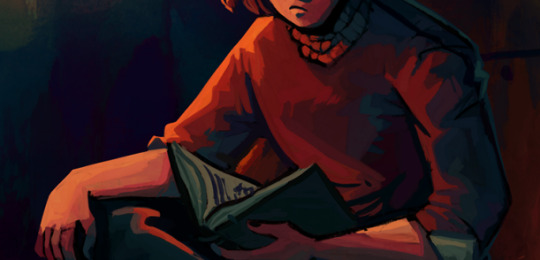
Here you can see the light parts are just a line of darker and darker colors (still I tried to vary the shape a little bit) but the shading on the chest is more varied and I use not only the transitional colors but change the hue a little bit as well so its more interesting to look at. My rule of thumb for the amount of colors I use for transitions is that I think if it's a hard or a soft shadow, if the light is a very contrasting color, you can make bigger jumps between colors and then as you aproach the darkest parts let the hue and lightness change happen slower.
.Also I use a lot and I mean A LOT of blending modes, if it's hard for you to change the hue very suddenly when painting, just paint the thing like it would be in a very soft netural lighting and then throw a bunch of colors and blending modes at it until you like it. I like to go over parts of my paintings with just a random assortments of shapes and colors that look somewhat plesant together and see how it looks with different blending modes, if I like something I will copy the original layer, merge it with the blending layer and do that a couple of times until I like the results. It's hard to explain how to do that properly tho, it's just something I learned how to use effectively by using it contantly.
Also this back and forth of changing things make my painting process a little bit slow, I'd say on avarage it takes me something like 6h to finish one art piece. It very much depends on the flow I have so I try not to get too attached to any piece of painting or colors etc so I dont feel bad when I go back and change things later.
I dont really use tutorials, my brain is very bad at learning by listening or reading, one exception being tb skyen's legends of runterra card reviews videos I know it's weird I dont even like lol and theyre very long but theres a lot of really good art there and him showing how composition works in them really helped me. I also try to collect art I like in my twitter likes and when I start a new piece I will go through them and see what elements inspire me, what painting techniques or color combos are interesting etc. Theres also a bunch of artstation accounts I look at when looking for inpiration, some of them being
Aleksander Rostov, Ismail Inceoglu, Julia Zhuravleva and Dominik Mayer
Hope this was useful, I went on a little bit of a rable there and I'm not sure if it makes sense, sorry :p
34 notes
·
View notes
Link
On tvN’s You Quiz on the Block, SUGA told stories from before his debut. The period of his life when he struggled with how to live off his music. SUGA and BTS have kept going and going for eight years, and now he’s on their grounds, where he can do anything he wants musically. What began with that long journey is the story of SUGA holding his head up higher and staring at the future, reaching for it.
How are you feeling after your shoulder surgery? You’re doing physical therapy in parallel with work.
SUGA: I’m all right. I’m keeping up with the physical therapy, too. I had surgery last year because I wanted to be able to go back to work sooner. I have nothing else to do except music.
You said that there’s nothing for you to do other than music in the “BE-hind Story” interview on YouTube, too.
SUGA: It’s true. I tried gaming, but I have no talent for it. The people I play with online get so frustrated if I do. I mean, I’m working hard and got some recognition in my life, and yet people bash me so hard in games. (laughs)
I wonder if there’s a game you can do better in than you do in your career. You’re currently at your sixth week at number one on the Billboard Hot 100 [with “Butter, at the time of this interview]. (laughs) How are you feeling these days?
SUGA: When we were at number one for two weeks straight, I was like, Wow, this is so amazing! But after the fifth or sixth week, we really started to talk about it between ourselves: I really can’t believe this. Anyway, I feel like I have a responsibility. And I think I’ll end up thinking much, much more when we get ready for the next promotion. Even if I just try to enjoy this situation, it hasn’t sunk in. We can’t leave the country, plus there’s lots of issues in the world right now that are much more important than how well we perform on the charts.
As you say, it’s a tough situation, all over the world. How do you feel about releasing “Permission to Dance,” with its positive message, at this point in time?
SUGA: It seems like everyone around the world is really tired of this situation dragging out. I wanted to convey a message that tells people to keep hanging on to hope until the very end. Whereas we released the album BE in this situation, seemingly without any certainty, I believe things will slowly get better now. I don’t know if we can go back to the way things were before, but I’m still working with the hope that we can return to a situation that resembles what we had before.
Aren’t you tired of the pandemic being in this prolonged state?
SUGA: I look at it as, when you lose one thing, you gain another. I ended up being able to see my family more since I’m in Korea. In that sense, I feel more stable, so I’m not so much tired as hoping each day that things will become okay soon. I keep moving back and forth between work and home, and I’ve started to reflect on parts of myself I didn’t know about before. Like that I feel somewhat comfortable when I start and finish work at a certain time. While I used to have to go to bed at a certain time for work the next day or else I had a hard time getting up early, now I know I’ve figured out what time I should wake up at to make sure I feel good all day. What I pursue in life is emotional stability, and I don’t think there’s really anything too exciting or sad happening these days.
What effect do those emotions have when you work on music?
SUGA: They don’t have a big effect on it. I think it affects the way I write lyrics a bit, but I’m not working on any lyrics at the moment. I’ve been making music for a long time, so I think it’s possible for me to express emotions I’m not feeling in the moment. And it’s good that we released “Permission to Dance” in this kind of situation.
You sing rather than rap in “Permission to Dance.” In addition to rapping, you started singing more both before and after BE. What did you learn about your voice?
SUGA: “Permission to Dance” was a little bit difficult. I don’t draw a line between singing and rapping or anything, but it was different from our usual style, and the vocals were a bit high, too. So even though it took a while to prepare for it, I worked hard, and even when I asked some older musicians for their opinions, they all said, “It’s good the way you’re doing it. Don’t try to sing better—just sing more.” I think my only option is to sing more, like they suggested.
As far as style goes, you’ve been doing a smoother kind of pop music. Did any differences arise as a result of these changes?
SUGA: All things considered, the English was the hardest part. I paid close attention to my pronunciation in “Butter” and “Permission to Dance.” It wasn’t easy to capture that smooth feeling in the songs, so I practiced my pronunciation quite a bit. And I end up breathing a lot when I’m doing an English song, but the rap parts were a bit hard for that reason. There’s a clear difference from Korean songs, since English has so many syllables. But I don’t have any one method I stick with for my vocals yet, so I tend to try lots of different things out.
What do you make of BTS’s achievements over the past year with “Permission to Dance” and “Butter,” as well as the group’s change in style? In the space of a year, you’ve released songs in a style different from MAP OF THE SOUL: 7 or BE.
SUGA: As a producer, I think reactions are important to an artist who works within the field of popular music. With that in mind, speaking as a producer, “Dynamite,” “Butter” and “Permission to Dance” were the best choices. And musical tastes are different from country to country, and the cultures are different, too. Given that situation, I think it’s important that we’re a group who can send such a universal message out into the world.
BTS has really grown and changed a lot, starting with “No More Dream” and all the way to “Permission to Dance.”
SUGA: I think it’s a natural course of event for those of us who make pop music. Artists mix and match different genres as they grow, and the music develops as the people of its time listen to it. I’ve been listening to a ton of music lately, and thanks to the times we live in, if I listen to a song a few times, they recommend me more songs in a similar style. And after listening to them, I realized the style of hip hop is also changing and is splitting off into different offshoots. Other than hip hop, I also listen to a lot of instrumental music. I’ve always liked Hans Zimmer’s music. There have been many times where a movie I like turns out to have music by Hans Zimmer.
What is it about Hans Zimmer’s music that draws you in?
SUGA: I like orchestral music. There’s a lot of pop songs that are under the three-minute mark now, and whereas it’s sort of predetermined that they’re always written with intros that are four bars long, orchestral music can do a lot within its framework.
But, as can be seen in IU’s song “eight,” which you both produced and featured on, you broke out of pop music’s typical composition style and tried out a highly condensed progression. The composition of the chorus is very straightforward.
SUGA: Yes. I insisted that the flow be roughly cut in half from that of a typical song, and I expect more pop music will be like that in the future. And maybe even shorter as time goes on. I mean, these days there’s songs that are under two minutes, even.
Regardless, I felt the chorus in “eight” is extremely dramatic with its structure and the melody of the chorus. I thought it was rather grand in scale as well. Would you say that you’re attempting to mix your tastes and things you want to do into the structure of pop music?
SUGA: As you know, I love hip hop, so when I was first making music I thought it had to be hip hop no matter what and that I had to take pride in my own ideas and not accept any compromise. But while getting some experience at the forefront of pop music, I figured out that you can keep being stubborn or inflexible because there are people listening to you. There was a time I made music without any listeners before I became a member of BTS. But if someone were to ask if I stopped being stubborn about the music I’m making these days, the answer’s no. As I grew up and became an adult, I came to realize that I have to negotiate between what I want to do and the kind of music the public wants without compromising anything. When I give up on something I wanted to do, I ask myself, What will I get out of this? And conversely, when I want to do something, I ask myself, What can I get out of this? That’s how I keep my balance to make it to where I am now.
You have no choice but to think about those things when you work on other artists’ songs, especially when you’re a producer.
SUGA: I’m BTS’s SUGA, and I’m Agust D, and when I’m producing, I go by “by SUGA.” But when it comes to by SUGA, I make perfectly commercial music. I’m the producer for those songs, sure, but the owner is someone else, you know? In that case, they’re commissioning my work. But they wouldn’t think about just leaving it all with SUGA. The artist’s label has to think carefully about whether to commission me for producing and consider my situation, too, and those people must be hoping for something commercial. That’s the most important part of working with outside people. Actually, that kind of work isn’t much of a benefit to me, to be honest. Oh, he can write this kind of song, too. That’s all. The more valuable thing I can get from it is the recognition and records the artist or the company will get with the song instead.
As you noted in your previous Weverse Magazine interview, when you discussed your “interest in the music industry in the US,” you seem to constantly think about the things artists can do within the framework of the music industry.
SUGA: I don’t know. It’s just that I’ve become more certain since the pandemic started that I’m the kind of person who always has to be doing music. That much I know for sure, so I want to keep on making good music. And the pop music market is something that came about because there were people listening, and there’s a long history to the US music market, and it possesses the most influential charts in the whole word. So then I thought, Wouldn’t they have gone through all the same things that we have? And really, whenever I talk to other pop stars, the situation is always similar. The US is also more realistic about commercial results than any other country. I wanted an accurate picture of how those people work. Right now, Korean pop music’s spread is in full swing and we need more good artists to keep popping up. From a producer’s standpoint, if that’s going to happen, I think the key is how well we can mix our music and the characteristics of overseas music industries overall.
How did it feel to be in the lineup for the Grammy Awards, one of the icons of the US music industry?
SUGA: The feeling was less immediate because we couldn’t be there in person, and it wasn’t a huge distinction, but the performance made me think, This is different, because it’s the Grammys. What changed my view from the first time I went to an American music awards ceremony was, the first time I went, I was really scared of the world’s biggest music market. But when I look back now, I don’t think I had any reason to feel that intimidated. To be honest, I have only now begun to enjoy the awards ceremonies; I wasn’t able to then.
It’s no exaggeration to say that you’ve achieved most of the things that you can as an artist in the music industry. What steps do you think are necessary for the artists who follow after BTS?
SUGA: The way artists work seems so difficult. They make an appearance on a different music show every day once the promotional period begins, meaning the exhaustion artists face is enormous, and that fatigue often results in injuries as it adds up. That kind of music show is for promotional purposes, so it’s not like the artists can earn a proper income from them. On top of that, despite all the promoting, there’s no visible outcome, so they inevitably lose morale. If possible, it’d be nice to have one of the performances be really high-quality, even if it’s just the one, but in this environment I’d say that’s pretty difficult. And since our job doesn’t fit the common conception of work, there’s ambiguous boundaries when it comes to issues of legal protection as well. We need a lot of improvements to be made to the industry and its system.
They demand a lot of things as collateral for success, yet success is extremely difficult to attain.
SUGA: The great thing about the label I’m with is they listen to the artists’ opinions. I think both we and the label know to a certain degree what kinds of activities would be best commercially speaking. But the question is whether the body can endure it or not. If the fatigue builds up as you continuously do those promotional activities, it’s hard to do them the way you did when you first debuted. In that case, I think the label ought to actively accommodate the artist’s views about what they can and cannot do. An attitude that’s just like, Oh, we made you kids, and as long as you just do what we tell you to it’ll all work out, so just do it—I think that really doesn’t make any sense. Of course, there could still be situations where the label has to be pushy like that, obviously. But I heard there’s been times where a label will just say, Do it, without any explanation to the artist, or, Why are you talking so much? I think that’s the biggest issue and it’s destroying the industry. If you just see the artist as a product, how can they do anything creative? I really think it’s very contradictory to ask the people on stage to put on an enjoyable performance when they’re experiencing neither fun nor enjoyment.
That reminds me of the music video for “Daechwita” somehow. You appear onscreen as both a rebel character and a king, looking as different as your situation when you first debuted with BTS and your situation now.
SUGA: There was a lot I wanted to do in “Daechwita,” not just musically but also visually, and a lot of ideas came to me as I came to reflect on who I am as a person while working on the music video. It naturally occurred to me to separate SUGA, by SUGA and Agust D. The character I played in that video who wasn’t the king was a stranger. It takes place during the Joseon era, but then there’s cars and guns, which of course don’t belong in that era. I think we’ve been living our lives that way. Right from our debut, a portion of the hip hop lovers criticized us by saying, They’re idols. But at the same time, we heard things like, They’re not idols. I didn’t know which drumbeat to march to, so I think that’s why each of our albums took a different direction than people were expecting. But I don’t think I can call myself a stranger in this situation anymore. So these days my main goal is to keep going with BTS for a long time. Having a huge audience show up at our concerts is nice, but I think the goal for all of us is to make sure the group can keep making music even as we get older. I think right now we’re thinking a lot about how we can have fun and be happy on stage.
What do you mean when you say fun and happy music?
SUGA: I think people are happier the busier I am, so lately I’ve been thinking that I need to focus a little more. I figure we should do as much as we can for ARMY since they feel happy watching us. We’ll continue to try our best, so I hope they believe in BTS and keep their eyes on us.
So that’s why you do music.
SUGA: This is the only thing I know how to really do. Other than music and BTS, there’s nothing special about me when I look at this 28-year-old Min Yoongi. That’s why I want to keep doing this.
146 notes
·
View notes
Text
Juulia Turkkila and Matthias Versluis 11/3/94 and 7/18/94
2x Finnish National champions

These two are very watery- so many water planets! Juulia has a stellium of 5 planets in Scorpio including Sun and Moon - this is intense energy, with strong emotions you may not easily show. She has Sun conjunct Venus, which gives a certain refinement and an affectionate nature and enhances your artistic talents. Her Sun/Venus also conjuncts her North Node: good luck and timing. Your most fulfilling life path and your true self are aligned. You will find support as long as you are authentic to yourself.
Her Sun/Venus conjunction squares Mars: inner tension that needs a physical and creative outlet. Can feel like you need to be doing something all the time. A fierce willpower, but asserting yourself can be challenging, which leads to frustrations. Intense and passionate in relationships, sometimes with very conflicting feelings.
Sun/Venus trine Saturn: a serious and conscientious hard worker who sets big but realistic goals. Trustworthy and loyal. Relationships tend to have a strong foundation. Able to structure and give form to your creativity. Success won't be early or instant, but rewards come from your hard work after time.
Jupiter sextile Uranus and Neptune: your positive attitude attracts opportunities and interesting people who can help you. a unique style which leaves an impression. Empathetic, intuitive and suited to the arts

Matthias is a Cancer with either Scorpio or Sagittarius moon. He has a LOT going on in his chart- several patterns with beautiful easy aspects bringing gifts and some big challenges to his sense of self worth.
He has Venus conjunct Chiron involved in all 3 patterns he has: this can mean wounds around self esteem, giving too much in relationships, but also sensitivity and empathy towards others
He has a high tension Mutable T-square, with Mars as the apex and Venus/Chiron opposite Saturn: feeling worthy is difficult, so you feel you have to prove yourself. Creativity and competitive sport are good outlets for this. You may feel frustrated and like it's hard to get what you want, but you develop a lot of discipline as a result
A Thor's Hammer with Venus/Chiron square Mars, with Uranus/Neptune apex: a lot of perseverance, trying over and over to prove himself, a lot of trial and error to understand how he relates to others. His Sun is at the trigger point of this Hammer and gives a strong need to do things his own way.
And he has a Grand Water Trine/Kite:
Mercury trine Jupiter trine Saturn: good common sense. loyal and dependable, ability to sustain hard work often leads to longevity. insightful and generous. can achieve big things, disciplined with strong work ethic, optimistic yet realistic.
Venus/Chiron opposite Saturn gives an outlet to these flowing energies: expressing the parts of him in this Grand Trine can help him learn to form loving connections and express his deep feeling nature and help him with his self esteem.

He has these gifts in addition:
Mercury sextile Venus: diplomatic and friendly, wanting to get along and for things to be pleasant
Venus sextile Jupiter: you're warm generous, and loving. artistic and musical

In their composite relationship chart, they have a Grand Water Trine with Mars, Jupiter and Saturn, so a lot of enjoyment in working together- their emotional natures flow into what they create, and there's an ease to putting their plans into action or physical work. A steadiness and understanding with each other, and good sense of timing,
Sun trine Uranus and Neptune: an ability to communicate sometimes without words. selflessness between you. a spiritual bond that can feel more platonic. trying new things, finding new ways to express yourselves and stretch makes you stronger. Honesty and openness are crucial
Sun conjunct Chiron: a relationship that has the potential to help you heal past hurts or help you move forward from situations which were limiting you
Mercury square Pluto: tension over ideas- a need to learn to open your own views to understand each other, otherwise conflict
Venus square Mars: can be an aspect of physical attraction. can sometimes cause competitiveness between you. but they both have this in their own birth charts, so how this plays out depends a lot on how they deal with this energy in themselves
Venus inconjunct Saturn: not sharing a lot of interests. need space to each do their own thing. compromise and patience required.

#fs astrology#figure skating#turkkila versluis#juulia turkkila#matthias versluis#omg these complex skaters
7 notes
·
View notes
Text
✏ bratfeen first date comic process! 💕
ok !! this is kind of a new thing that i’m trying out, which is that i’m just gonna ramble about my process about certain pieces/comics/Whatevers that i draw!
i’ll just be talking about my thoughts, drawing process, and also some struggles i had as i drew the whole thing. so if you’re interested in reading through all that and seeing some sketches/other bonus bits, keep on reading ! :-)c
(warning: v text heavy + veeery long post ahead! i get rambly LOL)
obligatory disclaimer: i’m a self-taught hobbyist artist so take everything i say with a grain of salt! i’m no pro and am not stating that i am one -- this is just my process. if you learn literally Anything from it, that’s super cool! :-Dc anyway, enjoy reading!
: : ♡ : :
OK !! god so this comic was SO fun to make, i had a great time planning things out, (mostly dialogue bubbles and where drawings will be cus i just love dialogue LOL) and also had a great time fussing about w 983749 overlays n whatnot (also becus feenie but shhh)
n e way since i really wanted this to come out good (+ just to get a general idea of how each page is going to be laid out) i made some thumbnails for each page! (shown below)
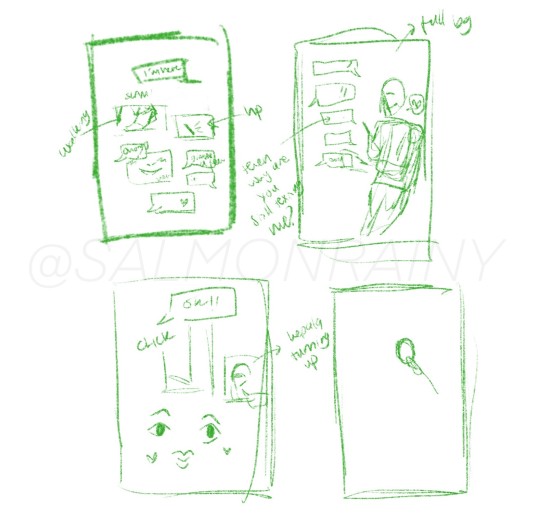
they’re very small, barebones, and very silly, but by making it i knew what i was kinda going for + it gave me a general idea of the layout of dialogue bubbles and where drawings will be (ig that’d be considered the composition? i’m not sure LOL). i always love planning out where bubbles will be in relation to the drawings (because i’m pretty sure that, with comics, dialogue bubbles kind of guide the reader’s eye through the page) so this was fun for me! i tried to keep the flow of the bubbles in mind to make sure everything was readable throughout the entire process of making this comic. also, with making thumbnails, i try to be quick about it, since i can fuss with the nitty-gritty of each page later on.
(ouuh but also notice that i didn’t really have anything planned for the Feenie Reveal page (the bottom right rectangle). that’s cause i just really had no idea how i wanted to draw him in at the time i was making thumbnails. this actually ended up making things v troublesome for me later on T_T (but we’ll get to that later!))
i then started out making more refined sketches of what each page is going to be like (shown below this paragraph; im sorry the pics are so big/make the post so long, tumblr formatting is a$$ T_T). to do this i basically just sized up each thumbnail to the size of the canvas and made more detailed sketches of what each page is going to be. this is kind of an important step, since this is what i later based my final lines off of (but i also don’t really have a streamlined process for making comics yet so i do tend to go back and forth with sketching & lines LOL). i also wrote in some of the dialogue here, just to make sure that the dialogue makes sense (though i did change/add some things later on!)

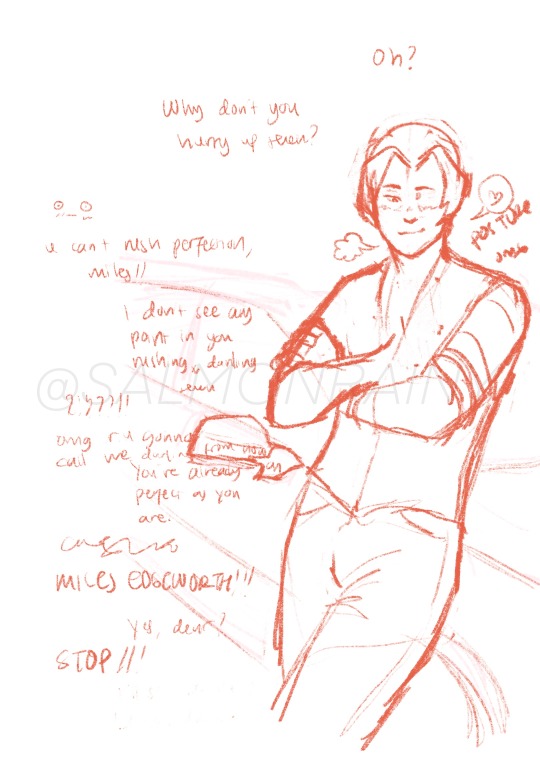
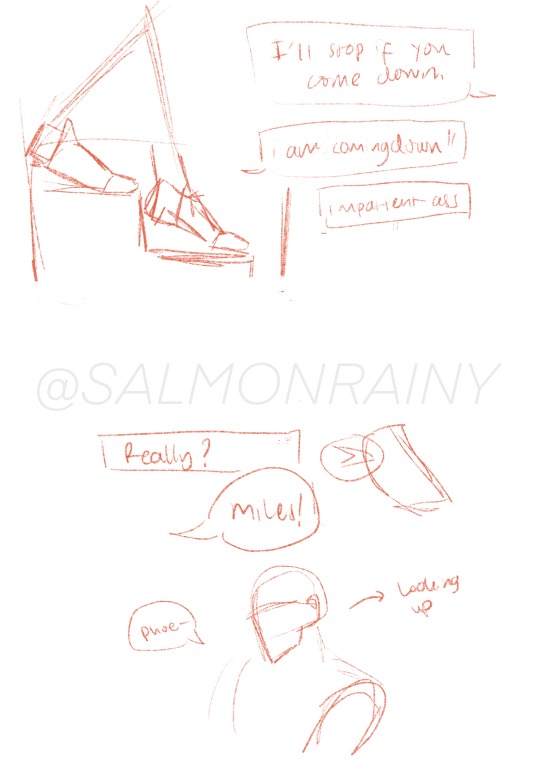

after that i just started going ham with drawing. as mentioned before, i don’t have a streamlined process with making comics so i still jump around between steps because my attention span is -7. i tried working on one page at a time, but again, -7 attention span, so i end up jumping between working on pages half the time LOL . . .
when i started putting down colours i struggled a bit since, initially, the colours i put down just didn’t seem right. i knew i wanted a dark background to represent it being like night time, but trying to make the colours of the lines, the characters, and other things work out was a wholeass mental workout. throughout struggling with the colours i always made sure to check the values of everything (chat bubbles, characters) to make sure everything makes a cohesive piece! i don’t have any pics for the colour process specifically, but i can show y’all the flats for the boys’ main fits:

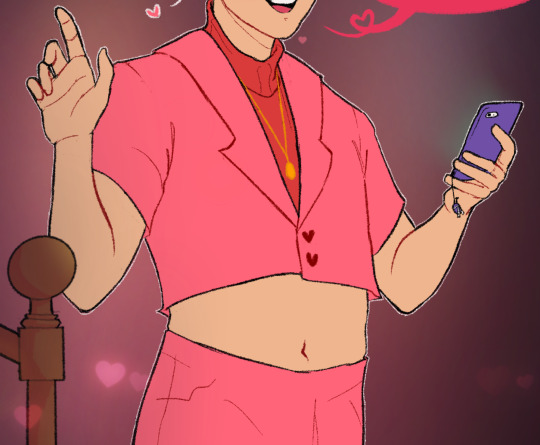
after i laid down all my flats i just went ham with shading. i did two multiply layers for each characters; one for like cel shading & another for a more soft shading look. i also just went ham with the background since i discovered the beauty that is the luminance brushes on procreate. i used the pulse brush a lot just to add more life & colour into the background of most of the panels, since most of them were just a plain dark colour at that time & that’s just boring LOL
: : :
REAL QUICK b4 we continue !!! i wanna talk about my feenie struggle. god, idk whats up with this one but this feenie gave me SOOO much trouble 😭😭😭 maybe this is due to the lack of planning in the thumbnail stage, but i really have no clue T_T i usually have such a Good & Easy time drawing him T____T </3 (i think i just need to do more studies for the human body + face from diff angles. . . LOL . . .)
but yeah ! for the final page i think i redrew him like 3-4 times total bc i couldn’t nail his pose + face down; i nailed miles in like the first or second go. i also had to like resize miles & feenie at some points bc they didn’t take up As Much Space in the panels as i’d like, since i didn’t want there to be an awkward thing of just Blank Space in the comic (if that makes sense). so that’s something i’m still trying to learn !
ok back to the main process LOL ⬇⬇⬇
: : :
after all of that i just finished up the dialogue bubbles + text. also, real quick add-on: throughout the whole process i keep going back to make sure that the dialogue bubbles + character drawings r balanced out & has a nice flow! also also, with the text/dialogue i debated using my handwriting vs the text tool for dialogue. i wanted a more Organic feel so i wanted to use my handwriting, but then realized my handwriting is absolute sh!t so i just used the text tool LOL
after adding in the text, i keep moving things around (bc, again, probs due to a lack of planning) and just fussed with everything until i like how things look. i added overlay layers, a lot of bokeh effect things, found a brush that did a heart bokeh thing (bless the person who created that btw holy sh1t), added a flat colour layer (i think i used a pink-ish colour) with the noise effect to add Texture etc etc.
and then i was pretty much done ! :-Dc
: : ♡ : :
if you’ve reached this far, holy shit, i genuinely thank you so much! i reaaally love rambling about m’process, so thanks for sticking around :-]c 💖💞 !!! if you haven’t read the comic (??? why r u reading this then LOL) / just maybe wanna check it out again after reading this, click here to go read it!
last thing before i go: support me on ko-fi! it’s absolutely not necessary, but if you like what i make and wanna send me a little tip, i’d appreciate it a ton. :-Dc
thank you 4 reading + have a wonderful day ! 💖💕
#if you have any questions regarding Anything i said in this post pls don't hesitate to ask me!#ALSO#THIS WAS A LONG TIME COMING WHOOPSIE#alsoalso part 2 is in the works ! pls look forward to it!#sal rambles#long post ///#comic process#process ramble#idk what else to tag LMAO#sal's comic#bratfeen first date comic process#AGAIN IF UR READING UNTIL HERE thank u sm ily :sob:
10 notes
·
View notes
Text
SUGA: “This is the only thing I know how to really do”
On tvN’s You Quiz on the Block, SUGA told stories from before his debut. The period of his life when he struggled with how to live off his music. SUGA and BTS have kept going and going for eight years, and now he’s on their grounds, where he can do anything he wants musically. What began with that long journey is the story of SUGA holding his head up higher and staring at the future, reaching for it.
How are you feeling after your shoulder surgery? You’re doing physical therapy in parallel with work.
SUGA: I’m all right. I’m keeping up with the physical therapy, too. I had surgery last year because I wanted to be able to go back to work sooner. I have nothing else to do except music.
You said that there’s nothing for you to do other than music in the “BE-hind Story” interview on YouTube, too.
SUGA: It’s true. I tried gaming, but I have no talent for it. The people I play with online get so frustrated if I do. I mean, I’m working hard and got some recognition in my life, and yet people bash me so hard in games. (laughs)
I wonder if there’s a game you can do better in than you do in your career. You’re currently at your sixth week at number one on the Billboard Hot 100 [with “Butter, at the time of this interview]. (laughs) How are you feeling these days?
SUGA: When we were at number one for two weeks straight, I was like, Wow, this is so amazing! But after the fifth or sixth week, we really started to talk about it between ourselves: I really can’t believe this. Anyway, I feel like I have a responsibility. And I think I’ll end up thinking much, much more when we get ready for the next promotion. Even if I just try to enjoy this situation, it hasn’t sunk in. We can’t leave the country, plus there’s lots of issues in the world right now that are much more important than how well we perform on the charts.
As you say, it’s a tough situation, all over the world. How do you feel about releasing “Permission to Dance,” with its positive message, at this point in time?
SUGA: It seems like everyone around the world is really tired of this situation dragging out. I wanted to convey a message that tells people to keep hanging on to hope until the very end. Whereas we released the album BE in this situation, seemingly without any certainty, I believe things will slowly get better now. I don’t know if we can go back to the way things were before, but I’m still working with the hope that we can return to a situation that resembles what we had before.
Aren’t you tired of the pandemic being in this prolonged state?
SUGA: I look at it as, when you lose one thing, you gain another. I ended up being able to see my family more since I’m in Korea. In that sense, I feel more stable, so I’m not so much tired as hoping each day that things will become okay soon. I keep moving back and forth between work and home, and I’ve started to reflect on parts of myself I didn’t know about before. Like that I feel somewhat comfortable when I start and finish work at a certain time. While I used to have to go to bed at a certain time for work the next day or else I had a hard time getting up early, now I know I’ve figured out what time I should wake up at to make sure I feel good all day. What I pursue in life is emotional stability, and I don’t think there’s really anything too exciting or sad happening these days.
What effect do those emotions have when you work on music?
SUGA: They don’t have a big effect on it. I think it affects the way I write lyrics a bit, but I’m not working on any lyrics at the moment. I’ve been making music for a long time, so I think it’s possible for me to express emotions I’m not feeling in the moment. And it’s good that we released “Permission to Dance” in this kind of situation.
You sing rather than rap in “Permission to Dance.” In addition to rapping, you started singing more both before and after BE. What did you learn about your voice?
SUGA: “Permission to Dance” was a little bit difficult. I don’t draw a line between singing and rapping or anything, but it was different from our usual style, and the vocals were a bit high, too. So even though it took a while to prepare for it, I worked hard, and even when I asked some older musicians for their opinions, they all said, “It’s good the way you’re doing it. Don’t try to sing better—just sing more.” I think my only option is to sing more, like they suggested.
As far as style goes, you’ve been doing a smoother kind of pop music. Did any differences arise as a result of these changes?
SUGA: All things considered, the English was the hardest part. I paid close attention to my pronunciation in “Butter” and “Permission to Dance.” It wasn’t easy to capture that smooth feeling in the songs, so I practiced my pronunciation quite a bit. And I end up breathing a lot when I’m doing an English song, but the rap parts were a bit hard for that reason. There’s a clear difference from Korean songs, since English has so many syllables. But I don’t have any one method I stick with for my vocals yet, so I tend to try lots of different things out.
What do you make of BTS’s achievements over the past year with “Permission to Dance” and “Butter,” as well as the group’s change in style? In the space of a year, you’ve released songs in a style different from MAP OF THE SOUL: 7 or BE.
SUGA: As a producer, I think reactions are important to an artist who works within the field of popular music. With that in mind, speaking as a producer, “Dynamite,” “Butter” and “Permission to Dance” were the best choices. And musical tastes are different from country to country, and the cultures are different, too. Given that situation, I think it’s important that we’re a group who can send such a universal message out into the world.
BTS has really grown and changed a lot, starting with “No More Dream” and all the way to “Permission to Dance.”
SUGA: I think it’s a natural course of event for those of us who make pop music. Artists mix and match different genres as they grow, and the music develops as the people of its time listen to it. I’ve been listening to a ton of music lately, and thanks to the times we live in, if I listen to a song a few times, they recommend me more songs in a similar style. And after listening to them, I realized the style of hip hop is also changing and is splitting off into different offshoots. Other than hip hop, I also listen to a lot of instrumental music. I’ve always liked Hans Zimmer’s music. There have been many times where a movie I like turns out to have music by Hans Zimmer.
What is it about Hans Zimmer’s music that draws you in?
SUGA: I like orchestral music. There’s a lot of pop songs that are under the three-minute mark now, and whereas it’s sort of predetermined that they’re always written with intros that are four bars long, orchestral music can do a lot within its framework.
But, as can be seen in IU’s song “eight,” which you both produced and featured on, you broke out of pop music’s typical composition style and tried out a highly condensed progression. The composition of the chorus is very straightforward.
SUGA: Yes. I insisted that the flow be roughly cut in half from that of a typical song, and I expect more pop music will be like that in the future. And maybe even shorter as time goes on. I mean, these days there’s songs that are under two minutes, even.
Regardless, I felt the chorus in “eight” is extremely dramatic with its structure and the melody of the chorus. I thought it was rather grand in scale as well. Would you say that you’re attempting to mix your tastes and things you want to do into the structure of pop music?
SUGA: As you know, I love hip hop, so when I was first making music I thought it had to be hip hop no matter what and that I had to take pride in my own ideas and not accept any compromise. But while getting some experience at the forefront of pop music, I figured out that you can keep being stubborn or inflexible because there are people listening to you. There was a time I made music without any listeners before I became a member of BTS. But if someone were to ask if I stopped being stubborn about the music I’m making these days, the answer’s no. As I grew up and became an adult, I came to realize that I have to negotiate between what I want to do and the kind of music the public wants without compromising anything. When I give up on something I wanted to do, I ask myself, What will I get out of this? And conversely, when I want to do something, I ask myself, What can I get out of this? That’s how I keep my balance to make it to where I am now.
You have no choice but to think about those things when you work on other artists’ songs, especially when you’re a producer.
SUGA: I’m BTS’s SUGA, and I’m Agust D, and when I’m producing, I go by “by SUGA.” But when it comes to by SUGA, I make perfectly commercial music. I’m the producer for those songs, sure, but the owner is someone else, you know? In that case, they’re commissioning my work. But they wouldn’t think about just leaving it all with SUGA. The artist’s label has to think carefully about whether to commission me for producing and consider my situation, too, and those people must be hoping for something commercial. That’s the most important part of working with outside people. Actually, that kind of work isn’t much of a benefit to me, to be honest. Oh, he can write this kind of song, too. That’s all. The more valuable thing I can get from it is the recognition and records the artist or the company will get with the song instead.
As you noted in your previous Weverse Magazine interview, when you discussed your “interest in the music industry in the US,” you seem to constantly think about the things artists can do within the framework of the music industry.
SUGA: I don’t know. It’s just that I’ve become more certain since the pandemic started that I’m the kind of person who always has to be doing music. That much I know for sure, so I want to keep on making good music. And the pop music market is something that came about because there were people listening, and there’s a long history to the US music market, and it possesses the most influential charts in the whole word. So then I thought, Wouldn’t they have gone through all the same things that we have? And really, whenever I talk to other pop stars, the situation is always similar. The US is also more realistic about commercial results than any other country. I wanted an accurate picture of how those people work. Right now, Korean pop music’s spread is in full swing and we need more good artists to keep popping up. From a producer’s standpoint, if that’s going to happen, I think the key is how well we can mix our music and the characteristics of overseas music industries overall.
How did it feel to be in the lineup for the Grammy Awards, one of the icons of the US music industry?
SUGA: The feeling was less immediate because we couldn’t be there in person, and it wasn’t a huge distinction, but the performance made me think, This is different, because it’s the Grammys. What changed my view from the first time I went to an American music awards ceremony was, the first time I went, I was really scared of the world’s biggest music market. But when I look back now, I don’t think I had any reason to feel that intimidated. To be honest, I have only now begun to enjoy the awards ceremonies; I wasn’t able to then.
It’s no exaggeration to say that you’ve achieved most of the things that you can as an artist in the music industry. What steps do you think are necessary for the artists who follow after BTS?
SUGA: The way artists work seems so difficult. They make an appearance on a different music show every day once the promotional period begins, meaning the exhaustion artists face is enormous, and that fatigue often results in injuries as it adds up. That kind of music show is for promotional purposes, so it’s not like the artists can earn a proper income from them. On top of that, despite all the promoting, there’s no visible outcome, so they inevitably lose morale. If possible, it’d be nice to have one of the performances be really high-quality, even if it’s just the one, but in this environment I’d say that’s pretty difficult. And since our job doesn’t fit the common conception of work, there’s ambiguous boundaries when it comes to issues of legal protection as well. We need a lot of improvements to be made to the industry and its system.
They demand a lot of things as collateral for success, yet success is extremely difficult to attain.
SUGA: The great thing about the label I’m with is they listen to the artists’ opinions. I think both we and the label know to a certain degree what kinds of activities would be best commercially speaking. But the question is whether the body can endure it or not. If the fatigue builds up as you continuously do those promotional activities, it’s hard to do them the way you did when you first debuted. In that case, I think the label ought to actively accommodate the artist’s views about what they can and cannot do. An attitude that’s just like, Oh, we made you kids, and as long as you just do what we tell you to it’ll all work out, so just do it—I think that really doesn’t make any sense. Of course, there could still be situations where the label has to be pushy like that, obviously. But I heard there’s been times where a label will just say, Do it, without any explanation to the artist, or, Why are you talking so much? I think that’s the biggest issue and it’s destroying the industry. If you just see the artist as a product, how can they do anything creative? I really think it’s very contradictory to ask the people on stage to put on an enjoyable performance when they’re experiencing neither fun nor enjoyment.
That reminds me of the music video for “Daechwita” somehow. You appear onscreen as both a rebel character and a king, looking as different as your situation when you first debuted with BTS and your situation now.
SUGA: There was a lot I wanted to do in “Daechwita,” not just musically but also visually, and a lot of ideas came to me as I came to reflect on who I am as a person while working on the music video. It naturally occurred to me to separate SUGA, by SUGA and Agust D. The character I played in that video who wasn’t the king was a stranger. It takes place during the Joseon era, but then there’s cars and guns, which of course don’t belong in that era. I think we’ve been living our lives that way. Right from our debut, a portion of the hip hop lovers criticized us by saying, They’re idols. But at the same time, we heard things like, They’re not idols. I didn’t know which drumbeat to march to, so I think that’s why each of our albums took a different direction than people were expecting. But I don’t think I can call myself a stranger in this situation anymore. So these days my main goal is to keep going with BTS for a long time. Having a huge audience show up at our concerts is nice, but I think the goal for all of us is to make sure the group can keep making music even as we get older. I think right now we’re thinking a lot about how we can have fun and be happy on stage.
What do you mean when you say fun and happy music?
SUGA: I think people are happier the busier I am, so lately I’ve been thinking that I need to focus a little more. I figure we should do as much as we can for ARMY since they feel happy watching us. We’ll continue to try our best, so I hope they believe in BTS and keep their eyes on us.
So that’s why you do music.
SUGA: This is the only thing I know how to really do. Other than music and BTS, there’s nothing special about me when I look at this 28-year-old Min Yoongi. That’s why I want to keep doing this.
© source
31 notes
·
View notes
Text
CNU “My songs match B1A4 completely…I can’t imagine anyone else singing them” [ARTICLE TRANS]
Here’s the translation to the recent interview that CNU did. You can definitely tell that they thought long and hard about what direction they want B1A4 to go in as a “new group” and you can also kind of see how he’s very sort of future facing in regard to the group. But, I hope you enjoy reading!
- Marisa
Part 1
Part 2
[t/n: I combined the two parts of the interview since the intros are the same for both parts]

The third person for this [I-Mind] is CNU (30, real name Shin Dongwoo) of boy group B1A4. CNU is the eldest and is in charge of vocals and dance in the 11-year group, B1A4. Additionally, he directs and makes music within the group as a ‘Composition Idol.’
CNU started by writing lyrics for the title song of B1A4’s second mini album ‘Beautiful Target’ and then composed the ending track ‘Seoul’ on their second full length album ‘Who Am I.’ Since then, he’s made songs in various genres and has showcased a broad spectrum of music from the emotional ‘Drive,’ ‘Call Me’ that has a trendy beat, and even the intense ‘Nightmare.’
CNU, who has been recognized for his composing ability, earnestly participated in the production of B1A4’s fourth full studio album ‘Origine’ that was released in October of last year. About the album CNU said, “I think that this album will influence the next 10 or 20 years and we tried to do music that utilized our strengths.” As a result, CNU’s name was listed in the credits of 8 of the 12 songs on the fourth full length album including the title song ‘Like A Movie.’ Thanks to that, the group’s identity was able to be in the song and even their musical maturity could be higher.
What will the future musical direction of B1A4 be? CNU has said that he wanted B1A4 to not be confined within a mold in regard to music and that even if they receive negative comments, he wants to do various things sincerely saying that he wants to create “music that listeners can look forward to.” He was also determined when he said, “I will work harder with the sense of duty that even with music, it’s not just to let the public know but also so that it can be recorded on one page of K-Pop.”
News1 met with CNU, a ‘Composition Idol’ that is full of musical greed.
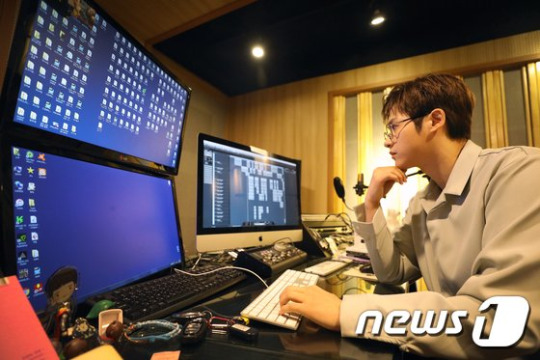
It’s nice to meet you. Please introduce yourself. I’m also curious about your recent situation
I’m CNU, the eldest in B1A4 and I’m also in charge of the mother role. We made a comeback two months after I was discharged in August and we also had a concert in December. (Smile) I’m glad that we were able to do that as soon as I was discharged because it was my goal to release an album.
If you were to introduce a representative song of B1A4 as a Composition Idol?
I think it would be ‘Like A Movie,’ which is the title song of our fourth full length album that we released last October. It’s the title track of an album that we released after such a long time and I’m fond of it because it seems to fit with our situation.
I’m curious about your style of working
I tend to worry a lot when I wrote about songs so it’s a kind of progressive and aggressive style. It’s hard but it’s also fun to make songs.
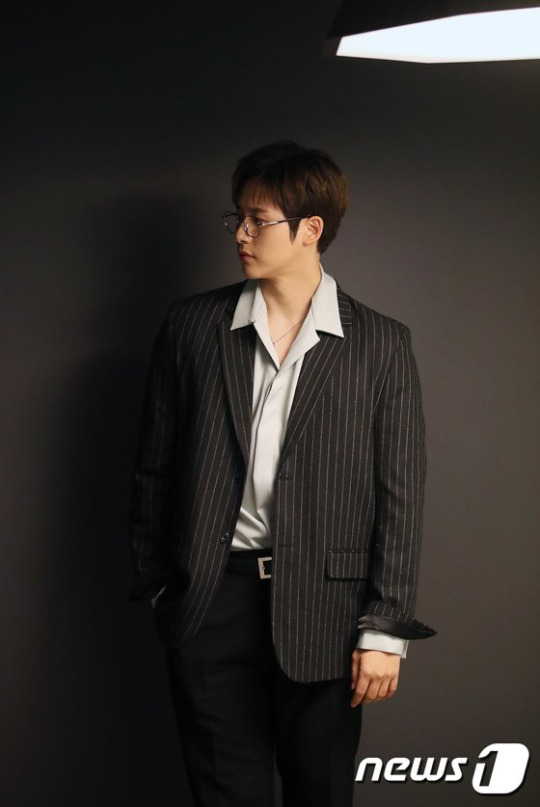
How did you first start composing?
I believed that there were a lot of things boiling inside of me and at first, the way to express those things was through song and dance. Then while completely working on the stage, I gradually had the desire to write songs so I tried to write lyrics. The first time I wrote lyrics was for the title song ‘Beautiful Target’ on our second mini album. I wrote the chorus and my part for the song. That then became my momentum and I thought that I wanted to continue writing songs. So by the second or third year, I bought equipment with my own money and started composing.
What was the first song you worked hard on?
That would be the song ‘Seoul’ that appeared as the last track on our second full length album ‘Who Am I.’ At that time I didn’t think like “I have to write a song!” It was a song that I was able to comfortably write without any expectations. It’s a side track that I wrote while thinking “Should I try to make one?” It’s a song that contains what I felt after coming to Seoul. Because all of the members are from the countryside, the city of Seoul has a different meaning to us. [t/n: in case anyone might not know, the countryside in this context is just referring to anyone that’s not from Seoul] The song details my honest feelings about how I felt when I came to Seoul to become a trainee and anyone that has lived in a foreign country will agree. It’s a place where I met my members when I had no one else to lean on and it’s a place where I was able to meet the fans after I debuted. It holds the message that in this cold city I only have the members and fans to lean on.
Since you didn’t specialize in it, you must’ve struggled and had difficulties while working
[t/n: specialize as in I’m assuming be formally trained in composing]
In the beginning it was really frustrating but I fortunately have a lot of good people around me. Artist Jooyoung is my good friend from my hometown. When I was making ‘Seoul,’ I asked him a lot of questions about music. At that time he told me about what kind of equipment I should buy and he taught me a lot about how to do the beats. I learned while doing that. Jooyoung and I were in a band club together in high school and the two of us promised to do a collaboration if we both succeeded in Seoul. (Smile) Later, I worked together with Jooyoung and his close friend Gureum to create ‘Drunk on Music’ and ‘Drive’ amongst others.
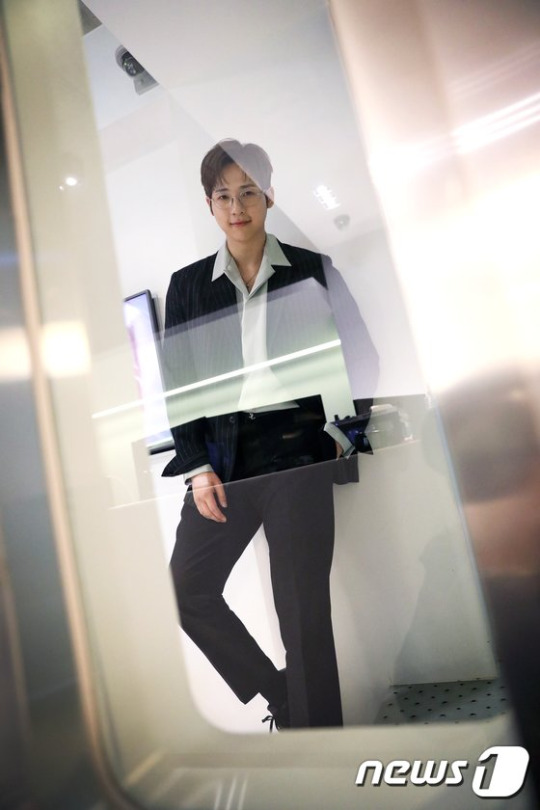
You must’ve been really proud when your own self-made compositions were included in B1A4 albums
I really was. It was a time when I was into mannerisms. I had doubts about myself as a member of B1A4 wondering, “Am I doing well?” Although I was working hard since our debut, I wanted to be of more help to the team. I then did some composing and created some results. Thankfully the reactions of the members and the company was good and it was able to be put on an album. I really liked it back then.
Did you want to formally study composing afterwards?
Personally, I don’t think that the concept of learning art is established. Rather than studying about it, I think that you should share and empathize. It’s about a person who has experienced many things letting the one who hasn’t know the way. I have seen how a lot of composers have written their songs, but eventually I did what it was that I wanted to do. Their way isn’t mine. You can receive some sort of influence, but you have to create the result in your own style. When people listen to the songs that I’ve written so far, they say “This is CNU’s style.” I tried to make my own path very clear.

When listening to the songs you made such as ‘Seoul,’ ‘Drive,’ ‘Nightmare,’ and ‘Sparkling,’ the genres and colors are all different. I can feel that you have a desire to create a variety of music
I didn’t intentionally attempt multiple genres, but I just made the music that I like and it could have been felt as being varied. Personally, ‘Nightmare,’ that was on our third full length album ‘Good Timing’ was a challenge for me as well. Who would’ve thought that B1A4 would do music that had a reggae beat? It was a style that I definitely wanted to try at least once and thankfully everyone liked it after I made it. I do have a greed and desire to broaden the spectrum with a variety of music.

What would you say is the biggest feature or differentiated color of music that you’ve made?
That it seems like music that has been specially made for B1A4. That’s also the part that I consider the most important when writing a song. I always worry about how I should incorporate the member’s voices into a song. I can’t imagine other people singing it because it completely matches with our tone. That’s why I don’t even think about giving songs to others.

Up until now you’ve only participated in the side tracks, but starting from your fourth full length album ‘Origine,’ you’ve become more proactive in creating songs. You participated in 8 of the songs and even made the title song therefore I’m curious about the process
It’s an album that took 3 years, from before I went to the army until it got released. The original goal was to announce it before my enlistment, but it took a long time because I went earlier than expected. I prepared the album all the way until I went to the army. I thought about it every day. When I was on vacation I wrote songs in the studio with a friend named Wooram and then I’d return and when I was on vacation again, I’d record. That’s the way I worked on it. I even asked the members to write songs and participate in creating the album. Personally, it was important because I thought about the album as something that will influence the next 10, 20 years of B1A4 so I thought about the direction. After thinking about it, we tried various things by using our strength as an ever-changing group. Even while feeling the weight of the year, we made a lot of effort for different music that will be further anticipated in the future. [t/n: I’m pretty sure the year that they’re talking about is the year that they became 3]
In the process of creating the album, was there no difference in opinion from Sandeul or Gongchan?
It matched well with the members. Although there were times when our opinions were slightly different, our desired directions and flows were the same. And because the company also agreed with our opinions, we were able to work while receiving more strength.

Out of the many songs, is there a reason why the title should have been ‘Like A Movie?’
Since it had been a while, I thought about songs that had our existing color and ones that had a different color and I felt like ‘Like A Movie’ seemed like the best in terms of B1A4’s new direction. Honestly, ‘Like A Movie’ is a dynamically composed song that has a melody line and no rap. Not having a rap is a big change in regard to idol music. Because we can’t help but think about that year, there is a sense of that weight but since we wanted to express B1A4’s unique charm, we made a new attempt. I don’t have any regrets because we gave forth all of our efforts. (Smile)
What is the most memorable compliment you have ever received for your songs?
In my final months of the military, I completed ‘Like A Movie’ and played it for the members. After I had come back, I had asked the president, executives, and successors to take a listen to it. When the song was over, all of them said that it was awesome. The successors may not be very objective (Smile) but I still can’t forget that expression. And I asked for a professional evaluation from the military band and was proud when they said that the rhythm and melody line was good. Even the boss praised me saying that it was really good and I gained strength from that.
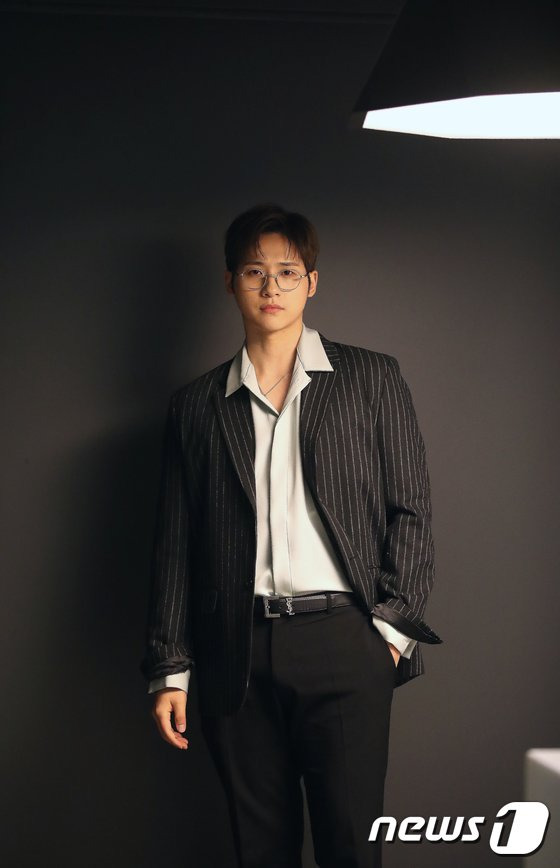
What would be the song that became a turning point for Composition Idol CNU?
It would be the fan song ‘A Day of Love’ that I made before I enlisted. It contains the message that I want to convey to the fans without being convoluted. Just like how BANA always think about B1A4, we also expressed our feelings of always thinking about the fans when we’re eating, when the wind blows, and in every moment of our daily lives. It’s a song that was made with honesty.
Out of all of the songs you’ve worked on, what is the song that you like the most?
The song that I’m most fond of always changes but right now it’s one of Sandeul’s solo songs, ‘Oblique Line.’ It’s a song that contains the feelings that I had during various changes. I had written it before joining the military and I had given it to him because when he listened to it, he said he really liked it and wanted it.

With the fourth full length album you decided to do music that was different from the usual music B1A4 released thus far. What kind of songs do you want to do in the future?
I hope that B1A4 is a group that doesn’t become confined to a mold. It’s my goal to make music that is unpredictable and causes future anticipation of “What kind of songs will they release?” I want to try an unlimited amount of various things and even if there is a negative reaction and we get scolded [t/n: scolded from the public], I have a big desire to try just that.
Do you have an artist that you wish to collaborate with?
There is an artist that I really wanted to collaborate with, but we collaborated on our fourth full length album. That would be Bibi who participated in my solo song ‘Zero Gravity.’ When I was in the military, I listened to their music and wanted to work with them so I asked for her to feature in my solo song and thankfully that worked out. When we went to record, I’m very thankful that Tiger JK-sunbae and Biji-sunbae gave all sorts of advice and I fell for both of them. Besides for BiBi, if there’s an opportunity, I’d like to collaborate with my role model, Taeyang-sunbae.

There’s not many Composition Idols in today’s idols. Is there someone’s songs that you want to compliment?
It would be ONF’s MK. When MK makes a song, he works really hard on it. Before, when ONF received a vacation, MK didn’t go and rest, but he stayed at the company to work. When I saw that, I felt his passion.
Please express your determination for future activities as a singer and composer
When I first said that I wanted to become a singer it was because I was simply thought that singing and dancing on stage was fascinating and cool therefore I set my mind on only becoming that. However, if you now ask me about what energizes me to make music, the answer would be BANA. Because the fans are there, I’m motivated and receive strength when I’m working or try to make music. I’m very thankful for that. I also try to be careful as I think that the activities that we do can have an affect on many people. I will work harder with the sense of duty that even with music, it’s not just to let the public know but also so that it can be recorded on one page of K-Pop.
23 notes
·
View notes
Text
Small Isles Interview: Filmless Music

Photo by Dustin Aksland
BY JORDAN MAINZER
It’s rare that you find a record with a genesis as specific as The Valley, The Mountains, The Sea, the debut album from Small Isles. The new project of guitarist Jim Fairchild (Grandaddy, former Modest Mouse) and songwriter/composer Jacob Snider has its basis in film scoring. The catch? The films don’t exist. The Valley, The Mountains, The Sea is presented as an imaginary score to an imagined sequel to Ang Lee’s 1997 familial drama The Ice Storm, itself based on Rick Moody’s 1994 novel. And the band’s upcoming, unfinished EP, with strings arranged by Snider and recorded by collaborator Sienna Peck, is, according to the band, a distillation of the concept of the band, one that consciously combines film scoring motifs with traditional songwriting. In a way, you could say that Small Isles is music about film scoring as much as scores itself.
Fairchild and Snider hold the belief that film scores should hold their own as a piece of music independent of visuals, and on The Valley, The Mountains, The Sea, they announce themselves convincingly. Opening track “The Concept”--essentially the prototype for the band--combines vaguely harmonic deep bass sounds with pristine, echoing string plucks, and wordless vocals, building up like an Explosions in the Sky tune. Other tracks, too, juxtapose the ambient with recognizable structures. “Fort Wayne” shimmers atop a drum machine, while the vocal samples of “Maybe We Will” cut in and out among the beats and arpeggios. Each track also has a pristine sense of place, as much of the album was written while Fairchild was on tour with Modest Mouse, tracks like “Fort Wayne” and the washy, atonal “Lake Superior” started in those locations.
I spoke with Fairchild (calling from his home in Ojai, California” and Snider (calling from near Philadelphia) last week, a few days prior to the release of the album via AKP Recordings. (The album comes out on vinyl next month). Read our conversation below, edited for length and clarity, about the band’s artistic process, The Ice Storm, adapting the songs live, and what Small Isles has in common with Olivia Rodrigo’s Sour.
Since I Left You: You’ve called this record an imaginary score to an imaginary film. Did you think of the sequencing of the record in a narrative arc?
Jim Fairchild: Kind of, but honestly, there’s a sequence that originally existed, and I don’t remember what it was, and it would have been more aligned with what I pictured from the movie, but it didn’t work as well as a comprehensive piece of music. The last song on here, “The Plot to Take Clover”, that was earlier before. “Life at One”, the first single, really kicked off me and Jacob’s partnership. It was designed that way; it’s not the way the record plays out. I wrote all of the principle themes, the underpinnings of all the compositions, as an imagined score to some sort of a sequel to The Ice Storm. I don’t know exactly how it would play out with Rick Moody. The first one was really successful. I have this idea for a similar type of movie that takes place in contemporary California and all these cues I can use as a mood board. Like, let’s sit down and figure out what this palate is. Let’s write a movie around it. That’s what I was thinking.
SILY: You wrote a lot of this while on tour. Had you conceived of the idea before then and wrote while on tour because of your downtime, or was the downtime the launching point for the idea?
JF: I was totally inspired by the idea. I started some of the themes that popped up, but once the actual Ice Storm Ang Lee idea came to mind, it was really generative. It’s how a lot of this stuff works with me. It kind of floats around for a while, reaching out this way or that. Once the real kernel appears, it’s like, “That’s it!” It all happens pretty quickly. That was definitely the case with this. It was the real fine-tuning that’s the most time consuming. That’s what Jacob and I have experienced. The EP that we’re releasing later this year, basically how it’s worked so far is I send him a sequence of chords and basic rhythm, which happens pretty quickly. Then--and we’ve only done it on Zoom with the new EP, though it was the same with “Life at One”--there was this theme. Jacob came in, we were gonna write some other stuff. He came in with a mic and sang some stacked harmonies. Then it’s carving out all the other elements around that to make it.
These are unconventional compositions. They’re meant to accompany visual ideas. With that in mind, cues and scoring music doesn’t always work in recorded music, traditionally speaking. There’s all these lengths, sometimes time signatures shift, a melody might exist in an unconventional way to fit what’s happening visually. I really wanted to embrace that. With “Life at One”, Jacob did all this stuff, and there’s this really interesting sound I don’t know how to describe. He asked, “What are those over there?” [My partner Natasha Wheat] had made these ceramic bells for me, and that’s the most fun part about working with Jacob. A lot of the people who are trained as Jacob is--and I say this with great admiration for his abilities--are stuck in certain modalities. This is a perfect example. He looked at the bells and said, “Let’s do that.” He grabbed a drumstick and played the edge of these bells and processed them. That was a big feature in the composition of “Life at One”. This all happens very thematically and reflexively, but to then carve it up and get it to have purpose, meaning, ebb, and flow and make it work visually--that’s where the dirty shit happens. [laughs] I also look forward to when Jacob and I can be in person more. We’ve made a lot happen over the past 7 months, but it’s hard when you’re not in the same room. Plus, I’d like to show off. If he’s sitting right next to me, play some fast guitar...[laughs]
SILY: The title of the record refers to various aspects of topography, and there are song titles that refer to specific places, like “Fort Wayne” and “Lake Superior”. Do these aspects exist within the narrative of the film?
JF: “Lake Superior” and “Fort Wayne” were just started in those places, literally. I picture the Ang Lee movie--the new Ang Lee movie that is inevitably gonna take form because he’s gonna hear me and Jacob’s music and think, “You’re right, we gotta do this,”--in this zone a little bit east of Berkeley. It’s the West Coast equivalent of the Connecticut zone where The Ice Storm exists. It’s this affluent, green place. But the reason I chose to keep the others as titles is like, Fort Wayne, that’s pretty grand and has Batman implications. And Lake Superior, what a fucking great name for a lake, you know? I like the power of those, and if I were sitting down and writing a movie, those titles could be at least generative of a conversation.
SILY: What about the other song titles? What inspired them?
JF: “The Concept” is literally the concept for our band. The concept has expanded since then, but out of the ordinary--no sounds are out of the ordinary in modern production--but in the film scoring landscape, out of the ordinary, ambient, or textural sounds. But then big, beautiful melodies. Jacob’s voice. All that stuff. Synthesizing our two strengths. Jacob’s also a songwriter and makes amazing songs, but my background’s in bands, and so I treat our relationship as if it’s a band. Taking our two strengths. Jacob’s more conventionally trained, schooled, and knowledgeable than I am. He has a richer depth of knowledge in theory and orchestration. I can arrange that way, but he knows what’s going on. Mine is more reflexive--I don’t want to say auto-didactic because that’s kind of an arrogant term--but learning through mistakes. I think Jacob’s made fewer mistakes than I have.
SILY: What were all the instruments used on the record?
JF: There’s a lot of found stuff. 12-string guitar. I was writing it using this Rosewood Fender Stratocaster that Fender made for me. The 12-string is prominent on “Life At One”. There’s a piano Jacob played. There’s a lot of me coming up with drum beats. A lot of the initial stuff was in the box. I’d roll in my portable studio backstage, I’d have a guitar, Universal Audio space, whatever drums and synths I had.
SILY: What is your background in film scoring?
JF: I don’t have a specific background. From a very early age, I’ve been into film scores. I’d buy them starting when I was 15 or 16. CDs. Pretty obvious releases, but things like Danny Elfman’s Batman score, The Good, The Bad and The Ugly. Sort of getting into Jerry Goldsmith. Elfman, Morricone. I like some of the Bernard Hermann stuff. I started studying it from the way I study everything: figuring out chord sequences, the way the melodies work, to the degree I was able. In the early 2010s, I was making a lot of music that was getting licensed for TV. Once Modest Mouse really started touring [2015 album] Strangers to Ourselves, I let a lot of those pursuits wither a little bit. But I’d always longed for a collaboration. A lot of that stuff was done in a solitary way, so I felt very fortunate when Jacob and I met. He was into that idiom but has a range of skills I don’t have. We also really work well together. All the reflexive stuff that happens, the melodies, it’s easy for us to go back and forth and see what we’re into and where to keep going. Neither of us get upset when the other person isn’t feeling whatever the direction is.
As I get older, I realize the value of stimulating multiple senses. I look forward to Jacob and I doing more of this stuff in collaboration with people. The Riley Thompson video for “Life At One” was him responding to a finished track, but in an ideal world, filmmakers would come to us and, in the way Trent Reznor and Atticus Ross work with David Fincher, where he says, “This is the concept for the new film,” and Jacob and I come back and say, “This is the sonic and melodic landscape we’re thinking of, and here are some character cues. Let’s take it from there.” I love being in conversation with people collaboratively and am attracted to the idea of it across media.
SILY: Do you think the idea that the music might not be responding to a finished film would make the score stand on its own more as a piece of music?
JF: The scores that I like totally stand on their own as music. When Morricone passed away, I read that John Zorn had a quote when they were hanging out in the late 80′s or early 90′s, Zorn said, “Don’t do it unless you’re thinking about what the soundtrack record is gonna be like.” The music needs to be cool enough to just be music.

SILY: Tell me about the album art.
JF: Natasha and I sold our place in Los Angeles last year and moved to Ojai. We thought it was a temporary transition, and now it’s somewhat permanent, because we bought a place here. We’ve been in this guesthouse next door since November. I like taking pictures at night with whatever ambient light [there is], so I took that picture from our place. I wanted there to be contrast with this technicolor paint and silver border on the upper and lower parts of the image. Homes are very interesting to me, and there’s a lot of that in The Ice Storm. There’s that shelf people look at from the outside and think, “It could be dilapidated, it could be beautiful.” People think of it as a thing. But there’s this whole other world that only exists inside of there. It’s always fascinating to me when walking by the place. Stories in the shell. I like the idea of a structure having implications. I don’t have an agenda for what those implications might be, but I like the idea that there could be implications there.
SILY: Jacob, when Jim came to you with this idea, how aware were you of The Ice Storm?
Jacob Snider: I had seen it. I don’t know if in our first meeting, it came up that specifically and clearly that this is where the music was going. In fact, it started more as a casual meeting of creative types. When I came over to Jim’s studio, he just showed me the latest thing he was working on without any huge idea behind it expressed to me in that moment. Jim might have been thinking it in that moment, but that day was more, “Alright, I’m working on something, what do you hear and is there something you think you could contribute to it?” It was really organic. Like Jim mentioned before, the best thing you can do when making something is show it to somebody else, because they’re gonna hear it in a different way or they might suggest something if you’re open to it. People can make amazing solitary music, but it will always be just their thing. You bring in someone else, there’s a different energy, a different perspective.
As it stands, I do love that film. It’s really haunting. Jim and I talked before that it’s not a movie you can watch every week. It’s heavy, and the themes are deep: family, loss, grief, betrayal. It’s a great one. I think it’s a movie that’s cinematic but also has a lot of depth. I think that’s what we’re going for with Small Isles. It has shades of film music but also shades of rock and roll and romantic string writing from the orchestral traditions. I think we’re trying to combine a few things at once, and we’re really curious how it starts to strike people and how some filmmakers respond to it.
SILY: Are you both generally Ang Lee fans?
JF: I haven’t devoured all of his work. There’s plenty I like. But I’m so in love with [The Ice Storm]. I was in love with the book before the movie came out. He treated it so beautifully. As high in the sky as it is for two nascent film composers to say, “I want to work with Ang Lee,” it’s very important to know where you want to go. It may take a long time to get there, but [it’s important] to have a place where you’re headed. That was definitely the case in the early Grandaddy days, and having watched [Modest Mouse lead singer] Isaac [Brock] for as long as I did, I think it was the case there, too. It may not be as specific knowing that I’m traveling in this direction, but that direction can totally change. There can be diversions that knock you off your course positively or negatively, but thinking about how beautifully he treated that material, that’s where I want to go.
SILY: How are you adapting Small Isles to a live performance?
JF: We’re gonna play at least some of this, maybe all of this live. I’m really looking forward to it. Jacob’s only on half this record, and the 5-song EP we’re releasing later this year, he’s on all of. That’s a straight-up 50/50 collaboration. I’m looking forward to the stuff Jacob didn’t contribute to on the record, hearing what he does with strings. We’re still figuring out how we’re gonna approach it. Jacob will be on keys and vocals, and I might sing a little bit. I’ll be on guitar. Our friend Sienna who Jacob went to school with, who’s doing the strings, we’re talking about having her lead a double string quartet. I would like to have a drummer doing some electronic drums and maybe a kit as well. I definitely don’t imagine we’ll totally nail it on night 1. There’s a lot of stuff we have to work out. There aren’t many antecedents in this zone, but something like Explosions in the Sky mixed with Johann Johannsson. I saw [the latter] in 2010 in San Francisco; there was a little bit of strings, various electronics, and he was on piano. That was a very striking performance. So the explosiveness of a big arena rock show with lots of subtleties and nuance that can come from strings and orchestral.
SILY: What else is next for Small Isles?
JF: We wanna finish this EP. I also really love the way a lot of rap and hip-hop people have gotten it right over the years. Using current listening habits and technology to get out as much music as possible. I definitely have the seeds for at least another EP behind this. Once we get this EP done--there’s just a little bit of tinkering to be done over the next month before going into the mixing stage--I want to make as much music as possible and release it. With the spirits of the world willing, I want to get off the ground live and collaborate with filmmakers, dancers, artists, people in the visual medium. I just love making music with Jacob and this type of music. I’d like to have a few releases a year. EP length [or] album length. I have a number of concepts written down. The seeds that Jacob and I have been playing with to make the EP. I was thinking about The Last Black Man in San Francisco when making this EP, and I’d love to collaborate with those filmmakers. Even just being in person, to tell Jacob, “What do you think of this sequence?” and have him respond without dealing with latency issues and dodgy DSL.
SILY: Anything you’ve been listening to, watching, or reading lately that’s caught your attention?
Jacob Snider: I’ve been listening to a lot of pop. I’ve been listening to the Olivia Rodrigo record [Sour]. I think there’s great writing on there, great production. Watching, I’ll just piggyback on The Last Black Man in San Francisco. It took me a while to finally see it, but I had a filmmaker friend tell me I had to, and I loved it. Also the other film Emile Mosseri did the score for, Kajillionaire, the Miranda July film. Reading-wise, I’m about to jump back into Louise Erdrich’s The Round House.
JF: I’ve been digging the Olivia record, too.
JS: There’s some cool strings on there too from the guy who does a lot of the strings for Portugal. The Man, [Paul Cartwright]. They created a string orchestra sound with just one guy layering violin and viola, which is really cool, and that’s what we’re doing with our collaborator Sienna Peck. There’s totally room for that now, the way the world has been so remote. We can’t put 16 players in a room right now due to public health restrictions, so let’s get one person. It’s really hard to do--you can be a great violinist and not be able to layer yourself in a way that makes it sound like a string orchestra. You have to change your position in the room, the way you’re playing slightly, pretend to be three different people sharing a stand. That’s what you’ll hear on the next record.
JF: I just got into How to Change Your Mind, the Michael Pollan book about psychedelics, which I really loved. I just started a book called The Magic Years, which is about child development. I have a three-and-a-half-year-old son, and I’m very fascinated by what’s going on in his brain and what makes him make the decisions he makes. Just how to be a better dad. I am always a religious reader of The New Yorker, every week it comes out. Natasha and I watched The Kids, a documentary [about the making of Larry Clark’s Kids]. When that movie came out, Grandaddy were skateboarders, so it was important to us. But even as a young kid, I felt that it was really exploitative, and the documentary verifies it. It’s heartbreaking. Larry Clark is a really derelict dude. Truly lecherous. But [The Kids] is a beautiful movie. We’ve been watching Los Espookys. I’m really excited about Vince Staples’ upcoming record. My friend Nik Freitas put out a new song. My musical diet’s gotten really regressive in a way because my son is very into the Super Furry Animals record Radiator. It’s all he wants to listen to in the car.
youtube
#small isles#akp recordings#the valley the mountains the sea#dustin aksland#jim fairchild#grandaddy#modest mouse#jacob snider#ang lee#the ice storm#rick moody#sienna peck#explosions in the sky#olivia rodrigo#sour#danny elfman#batman#the good the bad and the ugly#jerry goldsmith#ennio morricone#bernard hermann#strangers to ourselves#riley thompson#trent reznor#atticus ross#david fincher#john zorn#isaac brock#johann johannsson#the last black man in san francisco
5 notes
·
View notes
Text
Bloom #3
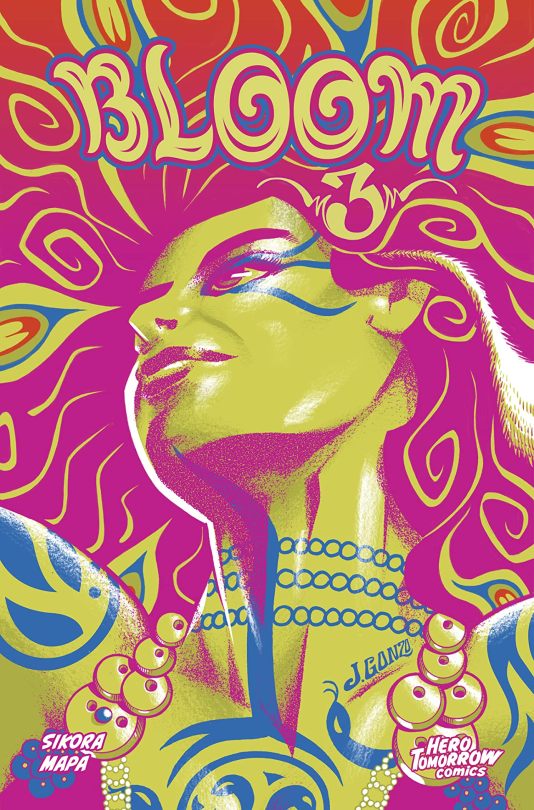
Bloom #3
Hero Tomorrow Comics 2021
Created, Written, Layouts, Coloured & Lettered by Ted Sikora
Illustrated by Buthc Mapa
The Origin of a Prophet Part III
It was supposed to be a simple photoshoot, but now Ramsey, the comic book artist, and Regina, his body-painted muse, have become hopelessly lost in the forest. Ramsey desperately wants to go home and forget the madness of these past twelve hours, but his surreal and psychedelic muse insists on going ever deeper into the strange!
I know way too many of you are sleeping on Hero Tomorrow Comics and you need to fix that. These books are way too good for you to be missing out on. This arc is all about a comic book creator who in creating a character paints a model with these symbols and unbeknownst to him it imbues Regina with strange and wondrous powers. Personally I also think someone else inhabits her body and takes over her mind in the process as well. See now this is just way too good to pass up because while it is out there there is something to be said about rashly acting on impulse without knowing what the consequences would be. It really engages the reader in some fabulous ways and it will stay with you long after you put the book down.
I love the way that this is being told. The story & plot development that we see through how the sequence of events unfold as well as how the reader learns information is presented exquisitely well. The character development that we see through the dialogue, the character interaction as well as how they behave then act and react to the situations and circumstances which they encounter. All this really brings new facets of their personalities to the forefront. The pacing is excellent and as it takes us through the pages revealing more of the story we’re so entranced by what’s happening it’s better than an LSD trip.
How we see this being structured and how the layers within the story continue to emerge, grow, evolve and strengthen is magnificently rendered. What I love about the layers here are the new avenues they open up and how we see these and the established ones being explored. With Regina’s new powers emerging along with this new personality we see how this great depth, dimension and complexity is added to the story. How we see everything working together to create the story’s ebb & flow as well as how it moves the story forward is impeccably achieved.
The interiors here are utterly fantastic. MInd you the duo is lost in the woods during Woodstock so the clothing we see is so retro cool and how we see them dressed is a huge bonus to me. The linework is clean, crisp and strong and how we see the varying weights and techniques being utilised to create this level & quality of the detail work we see throughout the book is completely and utterly fabulous! We see some great use of backgrounds throughout the book and they enhance and expand the moments perfectly. They also work within the composition of the panels to bring out the depth perception, sense of scale and the overall sense of size and scope to the story is marvellously rendered. The utilisation of the page layouts and how we see the angles and perspective in the panels show a remarkably talented eye for storytelling. The various hues and tones within the colours being utilised to create the shading, highlights and shadow work shows a tremendous eye for how colour works.
This is such a delightful book. How we see the events unfold and as Ramsey begins to realise what is actually occurring his fear starts to rise, and it very well should. There are so many things we see happening in this issue and it does really engage the reader and make you think in ways you might not expect or be prepared for. With such smart, intelligent writing and frighteningly good characterisation wrapped up in these beautiful and charming interiors will decidedly thrill and entertain you.

3 notes
·
View notes
Text
Five* Outside albums of 2020
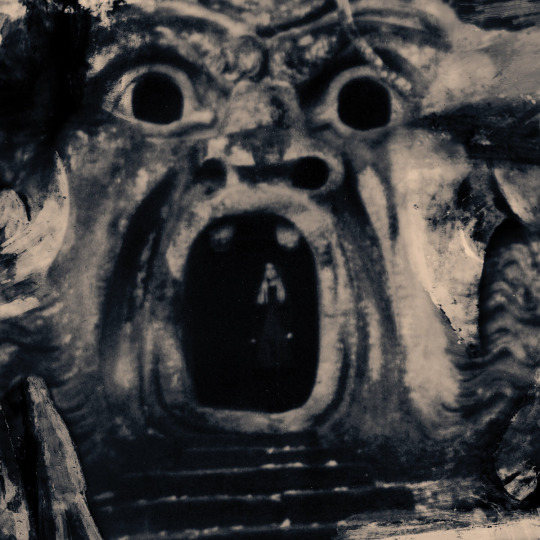
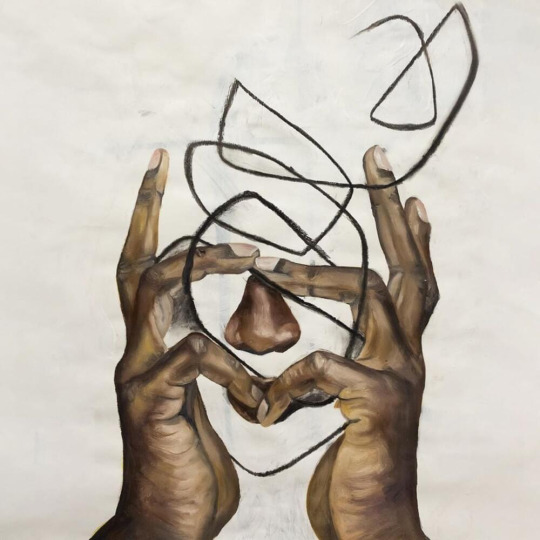

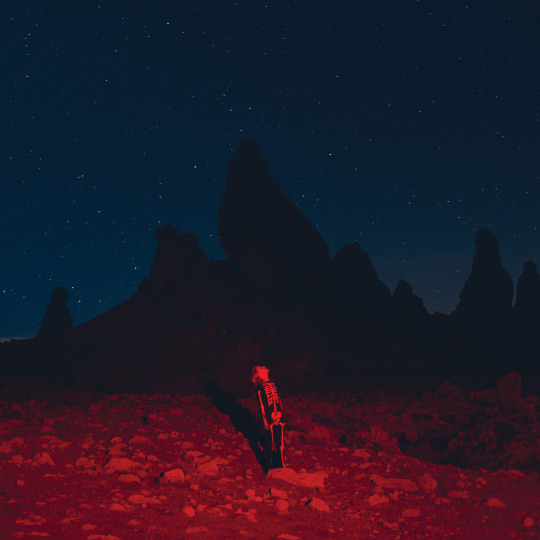

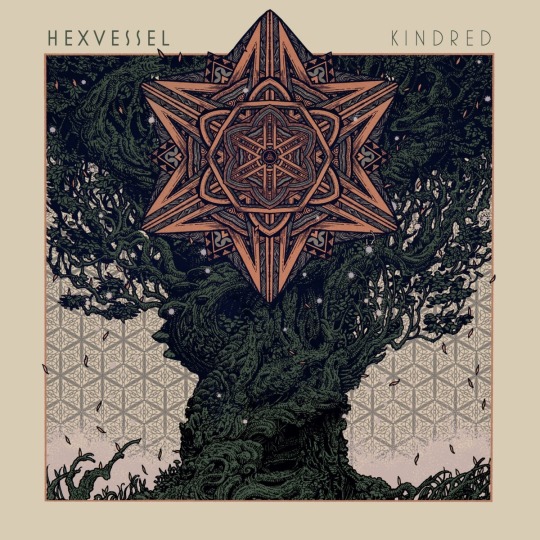
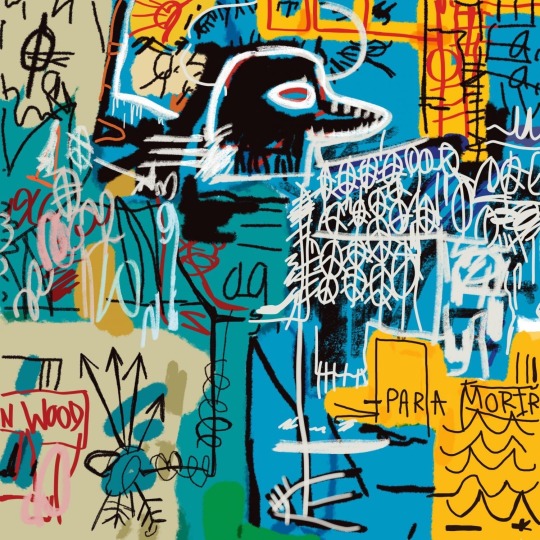

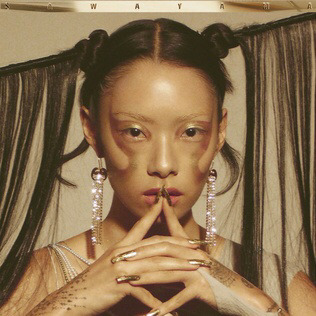

I do this little list every year of my favorite albums that fall mostly “outside” the metal sphere and weren’t so metal-adjacent that I reviewed them formally during the year. The past three times I have written this little piece, I have kept it to five, but *this year, I’ve just had a hard time narrowing it down, so I figured, why do that? Well, I could go through a few dozen albums or so that I fucked with this year outside the metal sphere, but I’m compromising with the addition of a new, quick (we’ll see) honorable mention section.
So, in the interest of keeping my verbose tendencies in check, I’ll cut this introduction off and get into the honorable mentions.
Honorable Mentions:
Anna von Hausswolff - All Thoughts Fly
I did review Anna von Hausswolff’s previous record, Dead Magic, back in 2018 as part of my bunch of metal albums reviews that year, because it was kind of tangentially metallic. It wasn’t a lot at a technical level, only a few metallic elements here no there, but it had a lot of harrowing qualities that I thought metal listeners might appreciate. For the Swedish singer and pipe-organist, that album really was the closest she ever came to metal’s territory, and I don’t think any flirting with the genre was intentional on her part. Most of what she does is haunting, neoclassical, organ-based music that’s usually not as wild as what Dead Magic was, and this year’s album is a real scale back to her roots and an appreciation for the pipe organ. While I do miss her bewitching vocals on this entirely instrumental album, All Thoughts Fly stands well on its own merits as both a solid tribute to von Hausswolff’s organ playing and as a beautiful, incredibly immersive ambient album that does so much with its relatively small palette. I’ve talked a few times on here about really shitty ambient music that’s approached with a clearly lazy attitude because of its supposed background role. Rather than being made to be ignored, All Thoughts Fly pulls you in and around in a swirl of lush sounds that aren’t too common in ambient music, and with a relatively minimal approach, relying on the naturally serene tambre of the instrument to fill the space with a lightening, floating ambience and well-structured movements to do the gentle moving. It’s a beautiful example of what an ambient album can achieve if it’s actually made with a lot of love and care.
Shabaka & The Ancestors - We Are Sent Here by History
Okay, that first one went pretty long. I’ll try to keep the rest of these here relatively short. Sons of Kemet band leader, Shabaka Hutchings, takes his other group on slightly less chaotic Afro-jazz odessey that what Sons of Kemet have been delivering us. While more contained on the surface within the genre’s usual light grey areas, Shabaka & The Ancestors move with freedom and flexibility on this album in a way that highlights the natural appeals of the Afro-jazz sound pallet through constantly engaging arrangements from masters of the craft.
Lady Gaga - Chromatica
I know we’re all well aware of Lady Gaga, but the pop icon has been relatively quietly been making the best music of her career since taking the edge rather than the center of the spotlight, from 2013’s diverse Artpop to 2016’s more bare-bones Joanne. And now, after her mellower, more traditional Americana-influenced album in 2016, Gaga cranks the volume and the fun way back up. Chromatica is a blast of an album whose wide span of dance pop albums influences new and old keeps it varied and lively all the way through. This album feels very much like it’s Gaga unleashed, just doing her thing and having a good time with a bunch of dance music styles that she’s always loved, and it’s impossible not to feel that enthusiasm secondhand, and groove the hell out along with it.
Black Thought - Streams of Thought, Vol. 3: Cane & Abel
Black Thought has had nothing to prove since the relative inactivity of The Roots this past decade, but he has sure been rapping as if he does have something to prove on his solo work. The Philadelphia rapper put out a couple of EPs back in 2018 that showcased his impressive modern lyricism and flow, and the third, LP-sized installment in the series is just another offering of further proof of the man’s lyrical chops. There’s a little bit of an understated delivery in the music overall, but Black Thought really lets his words speak for themselves more than his moderate bravado. It’s not super flashy because it doesn’t need to be.
Phoebe Bridgers - Punisher
Indie folk has always loved to soak in the puddles of personal sadness, but Californian singer Phoebe Bridgers takes the style to whole new depths of personally gripping, bordering on the outright emo, and that is by all means a compliment for rather than a shot at. The album’s candid journaling of Bridgers’ personal struggles is so tangible and so genuine that it would probably rival Connor Oberst’s best work with Bright Eyes. It is just a beautiful, yet tear-inducing album.
Alright, now on to the five “main” “non-metal” albums of the “list proper”.
Hexvessel - Kindred
Hexvessel are a Finnish six-piece whose sixth album of psychedelic folk here manages to touch on the same haunting, gothic tones that groups like Opeth and Gazpacho do at their most forest-y. Indeed, Kindred is an enchanting album, with sprawling styles and a full-bodied sonic pallet to keep it interesting the whole way through. And it’s as strong in its more bombastic song like that which opens the album as it is in its more stripped back acoustic tracks like that which closes it. Songs like “Magical and Damned” straight-up evoke Mount Eerie, while songs like “Kindred Moon” hearken to The Beatles at their most minimal and folky, and there’s plenty of spooky, mystical energy to go around. Definitely one of the best finds of the year for me.
The Strokes - The New Abnormal
Coming at the end of a seven-year gap between it and their previous album, 2013’s somewhat fan-polarizing Comedown Machine (which I liked a lot), The Strokes’ aptly named return is a return to the spotlight, but hardly to normalcy or the musical roots in garage rock that so many of the band’s fans have been sweating for. Twisting the electronic alternative rock of their Angles era into some odd, but mesmerizing forms, The New Abnormal is a subtly wild ride of an album through lots of melancholic overtones and undertones whose impact is made all the more potent by the occasional teasing of sorts with the few more traditionally rockin’ moments on here. It doesn’t take long to pull back the seemingly preppy synth rock or 80’s rock curtains to find the melancholy beneath “Brooklyn Bridge to Chorus” and “Bad Decisions”, respectively. But the band aren’t even that subtle with the immediate depression of just the straight-up guitar melodies on songs like “Selfless”, “Not the Same Anymore”, and the chill-inducing soar of “Ode to the Mets”. The album’s prize piece, though, has to be the utterly gorgeous and empathetic minimalist synth song, “At the Door”, whose simple melodies and bare delivery make for one of the most gently heart-piercing songs I know and of my favorite songs of the year and probably my favorite Strokes song ever, as hard as it is to listen to. Welcome back Julien and company.
Rina Sawayama - Sawayama
Quite possibly the best outright pop album I have heard in a long while, Sawayama sounds simultaneously fresh and vintage in the landscape it was born into, making use of a lot of early 2000’s pop rock instrumentation, even some heavy metal guitars here and there, but most importantly, a real sense of passion that seems to be flat-out absent from so much of the pop that I (usually inadvertently) hear. I don’t want to overstate the prominence of the metal elements, but the album does have a bubbling, infectious energy both vocally and instrumentally from front to back that the occasional bursts of heavy guitars between Sawayama’s charismatic, dance-inducing performances do provide a good snapshot of. Furthermore, there’s a rich diversity of song types across the album that dive into the pop sphere beyond the standard trend-hopping that dominates streaming playlists and make for a dynamic and fun, rather than disjointed, pop album. And that’s all only possible with the consistently tight compositions o the album. Indeed, this is one of the best pop albums I have ever heard, certainly in recent years.
clipping. - Visions of Bodies Being Burned
clipping. are the second artist to be on here two years in a row after last year’s spectacularly spooky There Existed an Addiction to Blood, and Denzel Curry’s one-two punch of TA13OO and Zuu in 2018 and 2019 respectively. There Existed an Addiction to Blood was a thrilling and fresh take on many tropes of horrorcore with the band’s already forward-thinking and creative noise-driven instrumental production guiding harrowing stories of femme fatales and street violence in a more modern setting that often flipped the script on victims and perpetrators, as well as settings themselves. Visions of Bodies Being Burned is quite literally a continuing sequel to that explosive album, also released in time for Halloween this year; the material was recorded in the same sessions as the previous album and in the same unique vein. Consequently, there’s not really a whole lot I can say about this album in contrast with the last without getting way too in-depth and spoiling the fun. Whereas MC Daveed Diggs’ hooks were one of the biggest strong points of last year’s album, the creatively noisy production is the big star on this album. The fans seem to be leaning a bit more toward this year’s release, but I think I’m still a little partial to There Existed an Addiction to Blood. Nevertheless, Visions of Bodies Being Burned is a blood-pumping follow-up not to be missed.
Mac Miller - Circles
The posthumous release from Pennsylvanian rapper Mac Miller captures the man at his most chill and contemplative. The album is more of a minimalist ambient singer-songwriter sort of album than hip hop and its serene atmosphere becomes kind of inadvertently tragic in the posthumous context, but it serves as a beautiful swan song for the creative rapper whose struggles with addiction sadly prevented him from being able to bask in the deserved wide appreciation of his sixth album. Circles is a soulful, bittersweet cap to Mac Miller’s legacy that I think anyone will be able to feel the love and raw humanness of.
#Black Thought#Streams of Thought#Streams of Thought Vol 3#Anna Von Hausswolff#All Thoughts Fly#The Strokes#The New Abnormal#Hexvessel#Kindred#Rina Sawayama#Sawayama#Phoebe Bridgers#Punisher#Lady Gaga#Chromatica#Shabaka and the Ancestors#We Are Sent Here by History
22 notes
·
View notes
Note
hi!!! first of all i adore your art so much!!!! like daddy jesus, it gives me life. u draw rlly good poses, so maybe u have some tips? or any good places to find references cuz i can only find pretty stiff looking pictures and thats sad :((((
Tips! Yes! I have those, since it’s a thing I’ve always struggled a lot with too, so I ended up hunting down and hoarding tips like an artist dragon with fancy pictures of gold - disclaimer, even though I know of these tips it doesn’t necessarily mean I’m good at following them. Because I’m a mess. SO! TIPS!
- When trying to decide on a pose, try to picture the whole action behind it instead of just the single instance! If we were to talk in animation terms, I’d say try to picture the whole sequence instead of just a single, specific frame of it. What is your character doing? Picture in your head the whole movement, and then pick a frame that’s smack in the middle of it - this is because generally the stiffer moments through an action are the beginning and the end of it, so drawing the middle will give your pose a lot more life! If you’re unsure about exactly which moment of the action would work best, draw thumbnails of a few different “frames” of it and pick the one that flows best for you
- Related to that, when looking for references generally I prefer looking for videos instead of pictures, specifically to get a better sense of how the whole movement flows and where it would be best to stop it. In the same vein, I’ve made a habit of at least partially always keep an eye out for body language while watching movies/tv shows/cartoons&anime, because while real life is just as much a good source of reference as anything else, actors and animators tend to exaggerate movements to make them more captivating and eye-catching, and that’s what we’re looking for when drawing too! It’s all in the drama of it, look for the drama
- “A real life person wouldn’t do that/move like that/bend like that”, that’s okay, this isn’t a real life person! Exaggerating the shapes and lines is a good way of increasing the flow of your pose, as long as you don’t make it grotesque then pushing on the shapes and curves is always a good idea! Unless you meant to go for grotesque, in which case push all you want, who’s to stop you. In this specific area action lines are your best friends, so if you feel your pose is stiff or lacks life, try finding the action line in it and push it more - you can find a lot of youtube tutorials on action lines and gesture drawing, in case you want to look more into that! Only god and my youtube history know how long I’ve spent doing just that
- Talking about youtube, if you want to work on your flow a good way is to try out the one minute figure drawing exercises - they give you a pose, you have one or two minutes to sketch it out depending on the video, then it moves to the next pose. It’s a good way to loosen up your lines, in my experience! This is a nice playlist for that, in case you wanna give it a go!
- Rewinding a bit and going back on body language, if you want your pose to feel alive and be realistic while at the same time conveying a specific mood or feeling, maybe you’ll want to look into how people express themselves through body language! I always see this suggested to writers to set the mood without explicitly stating the emotion, but it’s a wonderful tip for artists too the way I see it (mostly so if you’re drawing a comic, actually!). A good list is this one, give it a skim!
- More than a tip it’s a trick, really, but giving a prop to your character can help make the pose more interesting - there’s only a finite number of things a character can do standing alone by themselves with nothing to occupy them with, an object or an animal or a second character to interact with really do make finding an interesting pose easier!
That was a lot of theory there, wasn’t it, let’s go for some practical tips too (featuring Horikoshi’s pencil sketches, because I love them and he’s very, very good at this whole posing thing)
- If you picture your character as standing in an open space and the eyes of the viewers as a camera, moving the camera around them to find an interesting angle adds a lot of depth to the pose. It can be really, really tempting to just draw them from the front and eye level, but sometimes even just raising or lowering the camera the smallest bit helps with giving the drawing life - perspective! I know, I hate it too orz but we’re working hard to overcome that problem, because look at Horikoshi’s latest Kirishima sketch!

so alive! So beautiful! The pose in itself isn’t all that special, but the angle he decided to draw it at sure helps give him life. A thing I do often is to draw a thumbnail of the scene I’m trying to draw from the most boring angle possible, to make sure of where everything is, and then metaphorically move the camera around to try and find a more interesting angle to portray it from - it helps! At least, it does for me haha
- Keeping it asymmetrical makes the pose dynamic! Let’s look at Toga over here

Her legs and arms are an obvious example of this, but specifically I marked for you the hips line and shoulders line to show you how they aren’t paralel either, because that’s a little thing that’s generally a good idea to keep in mind when you want to give a bit more of movement to your posing! It’s true in photography too, actually. If you want a full body selfie to look good, try keeping shoulders and hips on non-paralel lines, it makes the whole thing look a lot more professional
- Keeping that Toga pic as our set example, hair and clothes give a lot of movement to the pose too! If you draw someone in the middle of an action, their clothes and hair are (possibly, if the clothes are loose enough and hair long enough) going to move with the action too - they show the direction of the motion, so keep that in mind when drawing them. Additional tip! If your character is just standing still, wind is a thing you can always make use of to give a bit more movement to the whole set-up!
- It’s a good idea to keep all the noise in your pose on one side, to give it a bit more balance and make it less chaotic - let’s use Jirou here as our example

the lines on the right side are a lot more simple and straight than the ones on her left, as I tried to very roughly mark for you - all details and “noisy” bits are all on the same side too, so that your eyes can easily focus on what’s important in the pic without getting lost all over the canvas. Balance and asymmetry! Again! It’s an easy way to make poses interesting, after all!
- That said, it’s not like you can never keep it symmetrical - the human brain actually likes that symmetry a whole lot, finds it compelling! It has to be perfectly symmetrical, though. Let’s look at Bakugou, because why not, always a good time to look at Bakugou

if you drew a line in the middle of his face and down his body, you’d see he’s pretty much perfectly symmetrical - that’s nice! That works! ...why does it work, though? This goes a bit more into composition and less into posing, but this has to do with the rule of thirds: generally and very simply, the rule is that for a picture to be well composed it needs to be set so that the main focus isn’t smack in the middle of the canvas. Some examples with the pics I just posted up there!
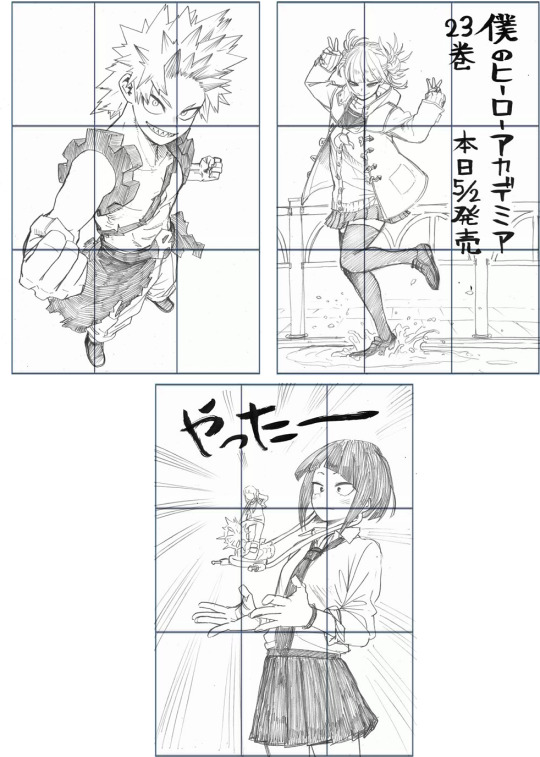
The way the bodies are positioned and the way in which the empty spaces are used respect the rule of thirds pretty dang neatly, and that helps make the pictures look less stiff too, between the others things! It gives balance to the whole composition, and makes it more lively! (The reason why it works with Kirishima is that the focus of the drawing is less him as a whole and more his face and right fist - so very neatly positioned! I’m in awe, ngl)
Bakugou’s case is a bit different thoguh, and that’s why the symmetry works there!
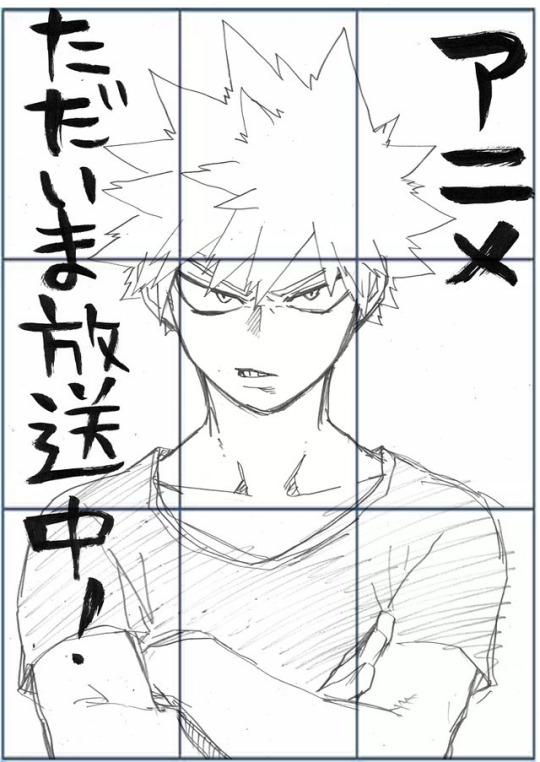
when you want to go for the symmetrical look you sort of need to forget about the rule of thirds, as far as I’ve been thought - symmetrical means tidy, and it’s only really tidy if it’s symmetrical based on a line traced right in the middle of the canvas, so Bakugou’s center is right along the median axis, and his pose works even if it’s pretty stiff, by all means.
(this goes into the rules of making a good portrait work, actually, but the lack of empty space all around him helps with keeping it looking well composed and tidy, too. There’s a lot of little tips and tricks that help make a pose work when it comes to composition, really!)
(Also, to be fair this last bit about the rule of thirds wasn’t exactly necessary or particularly well explained, I’ll be real, but while browsing Horikoshi’s twitter I realized how neatly all his sketches follow the rule and I needed to gush about that for a sec, it’s how being a fan works haha hope it was useful at least a bit to you, though!)
#fran answers#art tips#long post#so long!#but i hope at least something in here might be of help to you#posing and composing are a very very complex and big topics#i'm still working very hard to try and figure it out myself#let's do our best together!#sexy0android
2K notes
·
View notes